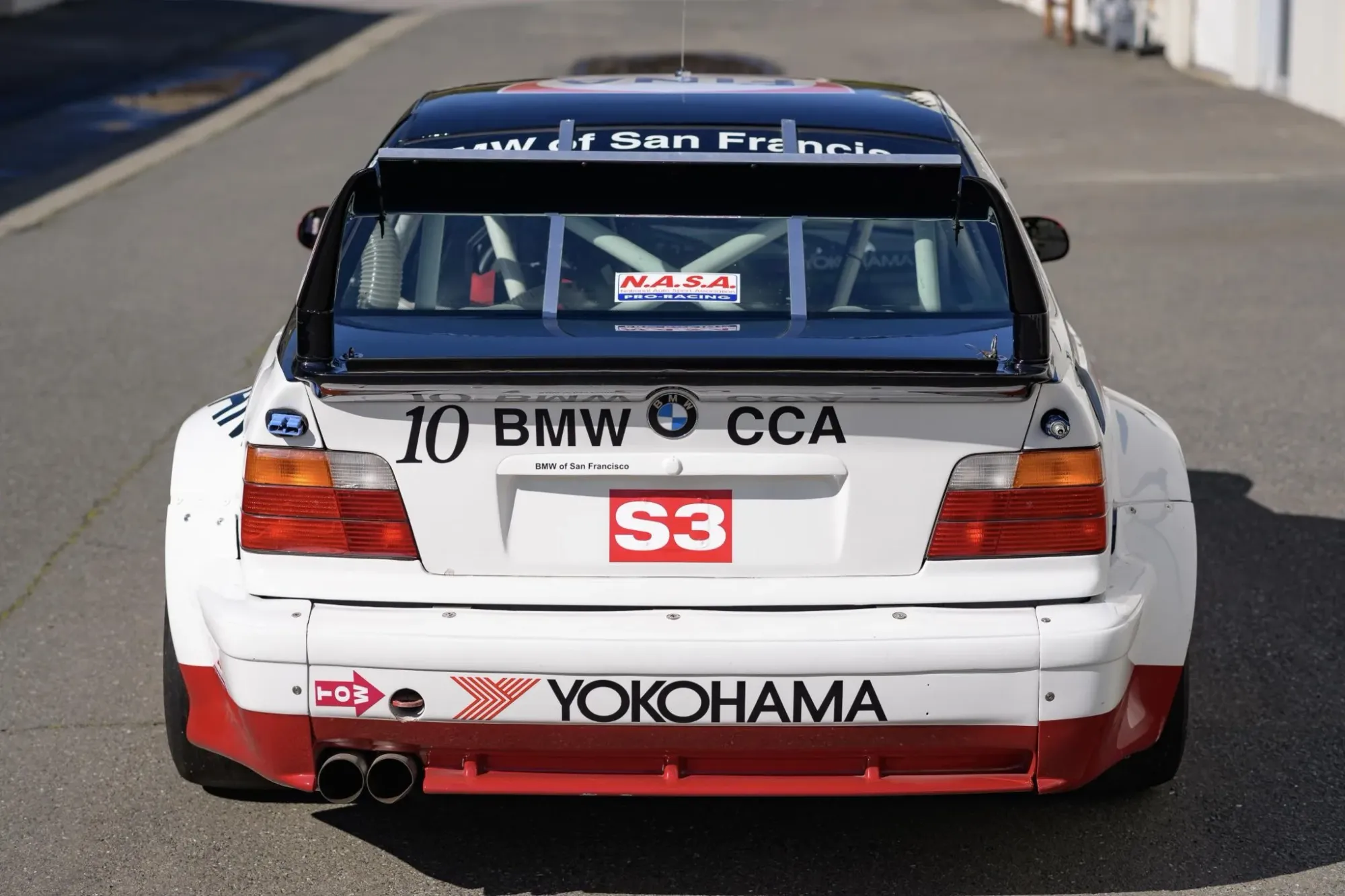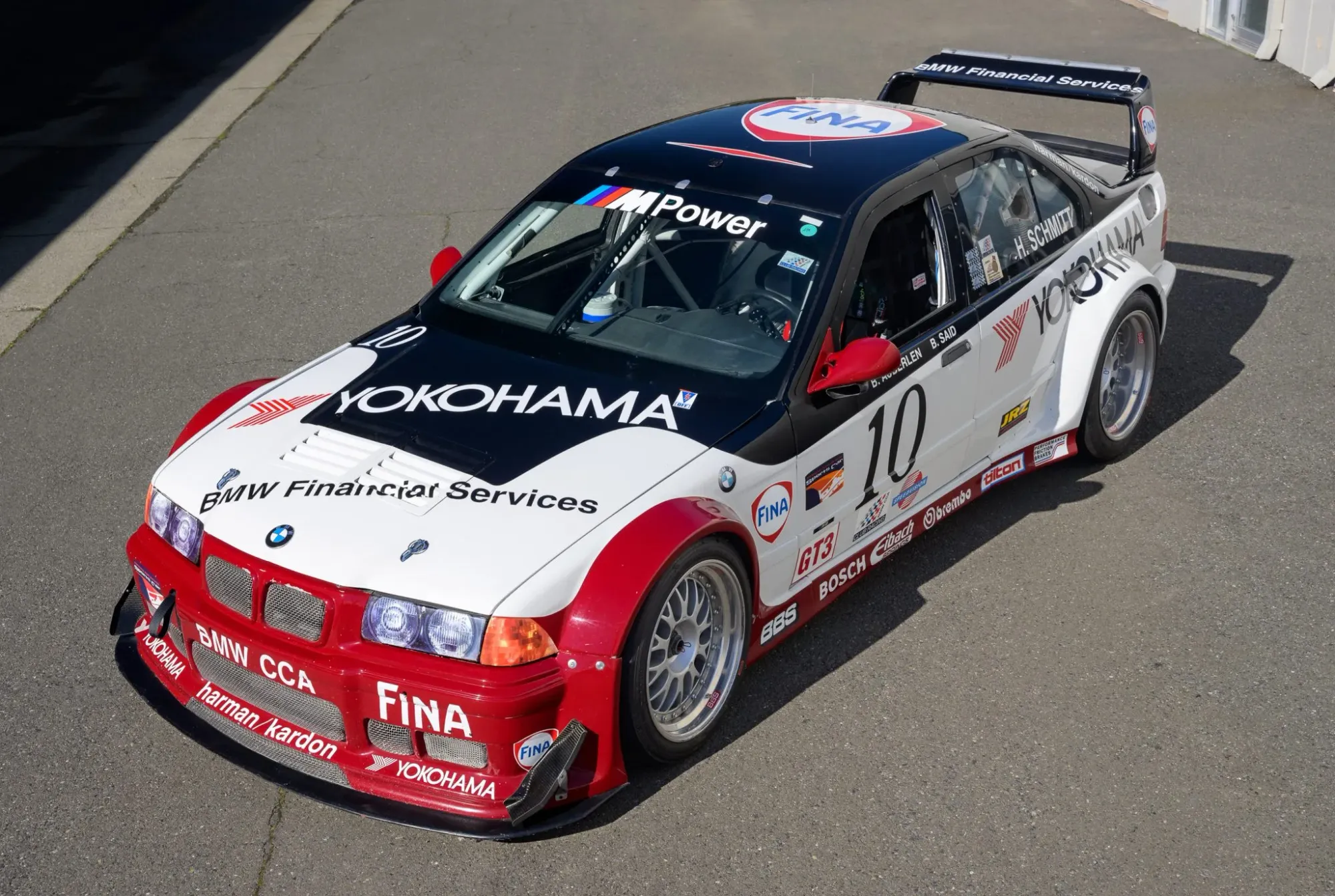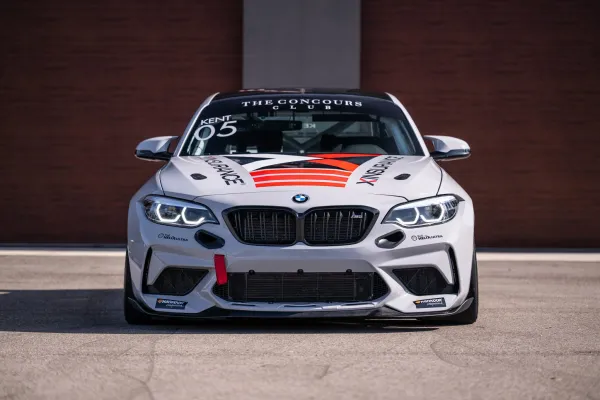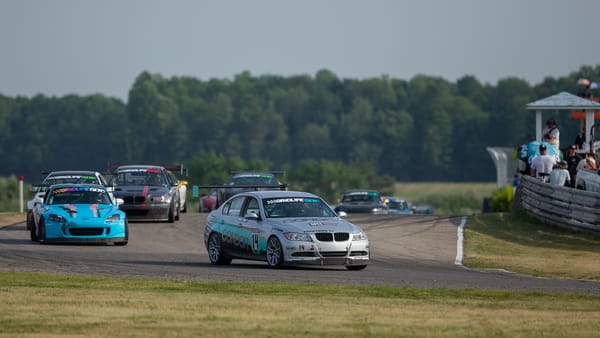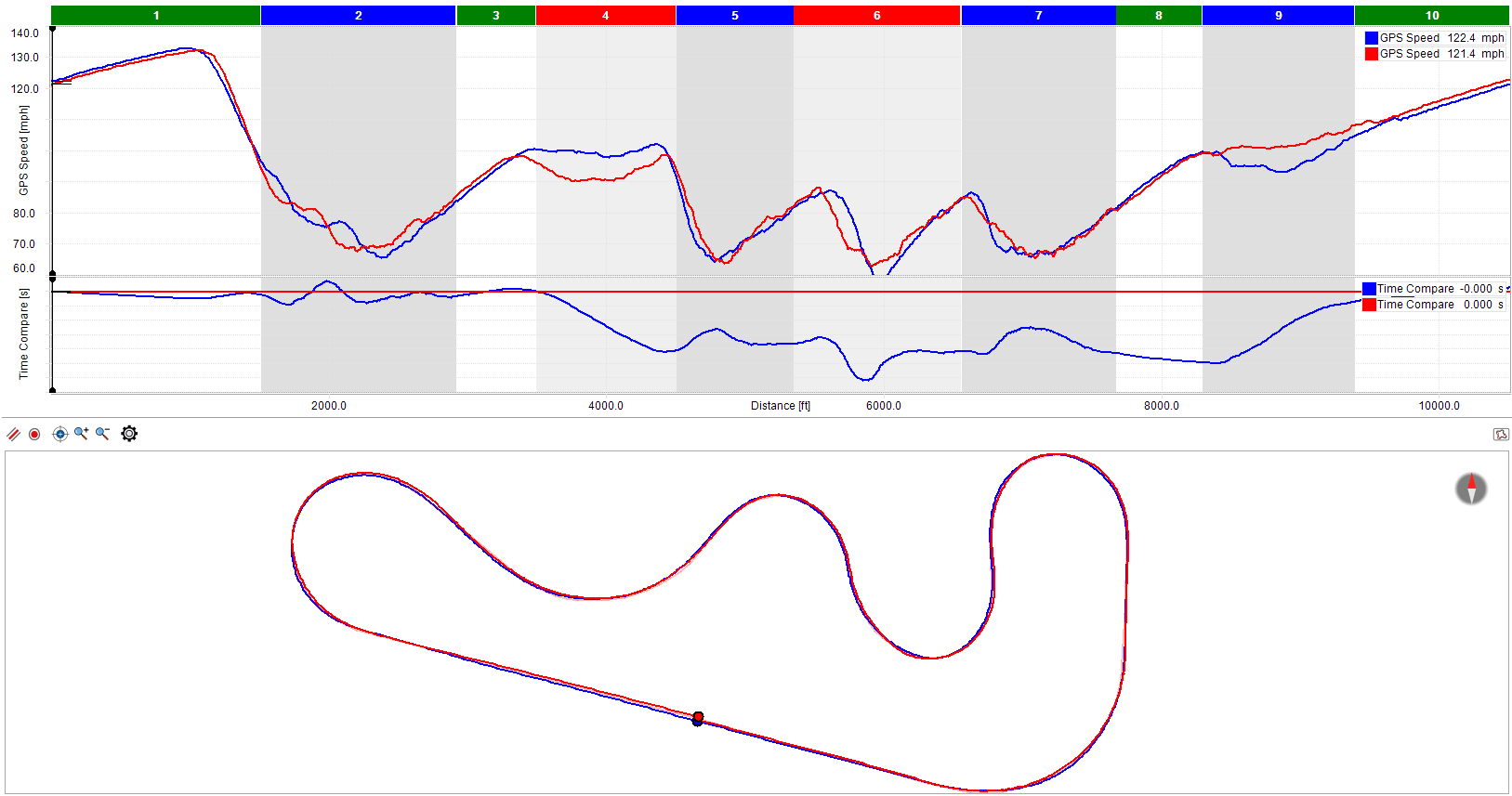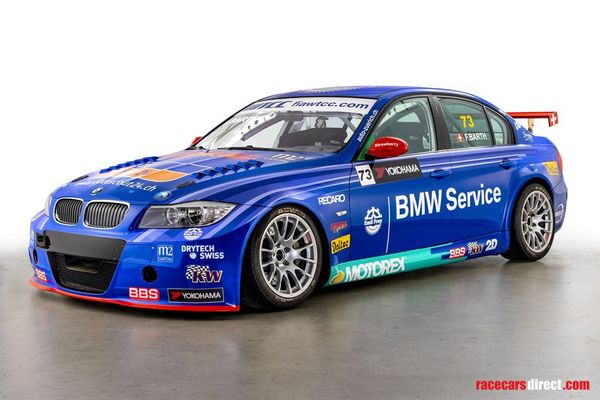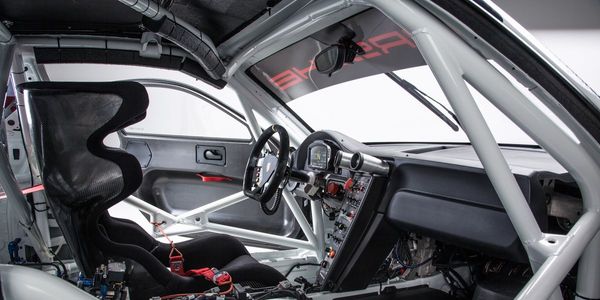Say the letters "PTG," and any E36 fan will immediately have a mental image. Prototype Technology Group campaigned their BMW-contracted E36 M3 program to great success in the mid-late 1990s. The GT3 class cars featured distinct bodywork, impressive development, and legendary drivers (Bill Auberlen and Boris Said, amongst others). It's no wonder the program was so successful.
One of the seven storied PTG M3s hit the auction block at Bring a Trailer this week. The particular car being auctioned won both the 24 Hours of Daytona and the 12 Hours of Sebring back in 1999.
While flipping through the 255 highly-detailed photos included with the auction, I thought it would be fun to dissect the aspects of the car that I find interesting and noteworthy.
At the time of writing, this auction had 9 days remaining, and it was already bid up to $211,000. I'm excited to see what this historic race car hammers at.
You can find the auction here. The photos are all borrowed from the auction, and are copyright their respective owners: presumably Bring a Trailer, and the seller, CSL-PTG-EVO.
Note: you can click on any photo to enlarge it.
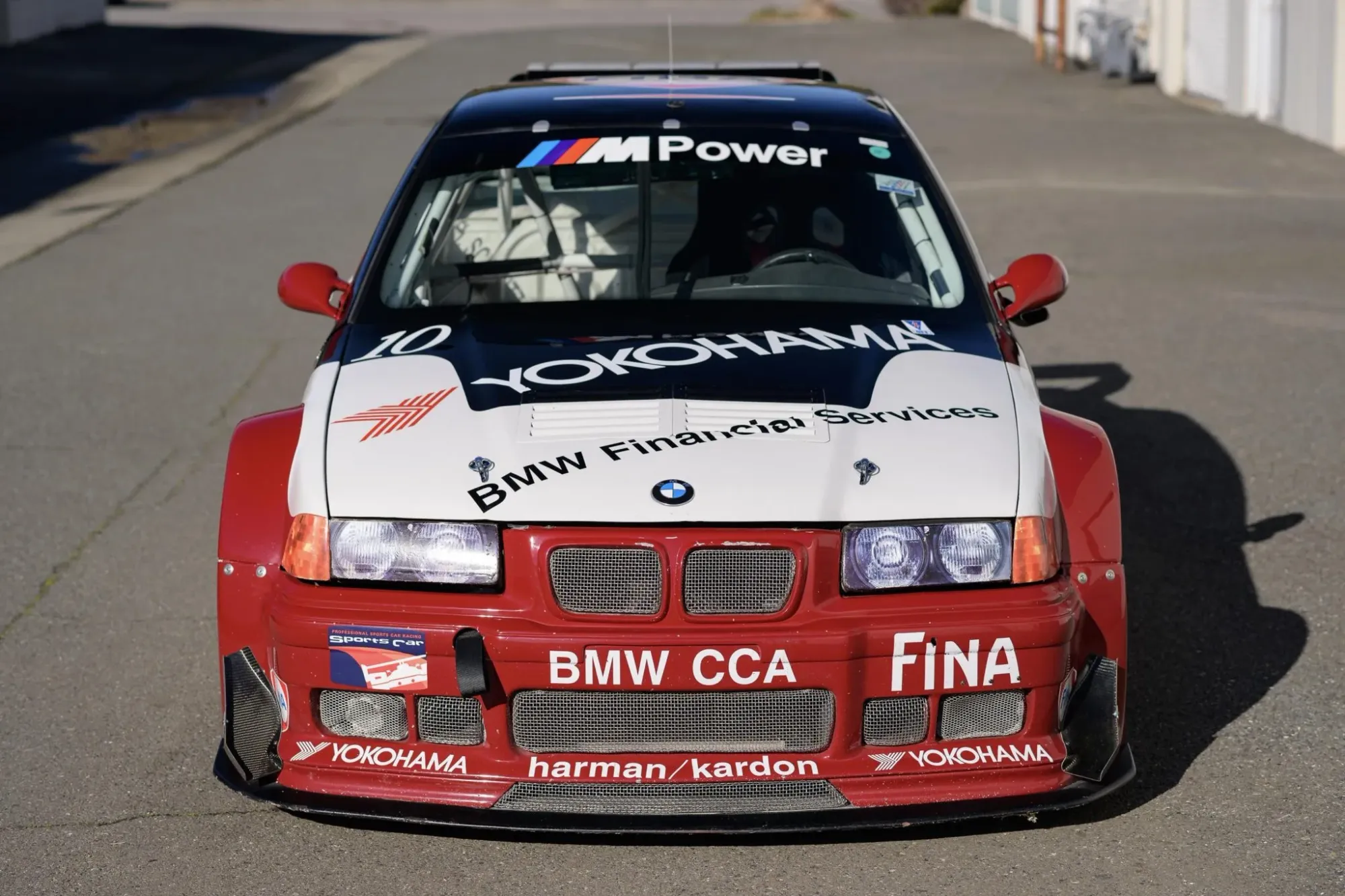
Frontal Area
The canards look cool. I suppose they are meant to scoop some air away from the massive fender flares, while providing some front downforce. The splitter is relatively small and thin. I wonder what the class regulations were. It doesn't have a full chord wing, so it probably doesn't need much splitter either.
There are massive gaps around the headlights and hood. By modern aerodynamic standards, I think they would have closed some of those gaps up, at least.
I wonder if they are using all the openings in the bumper, and what for.
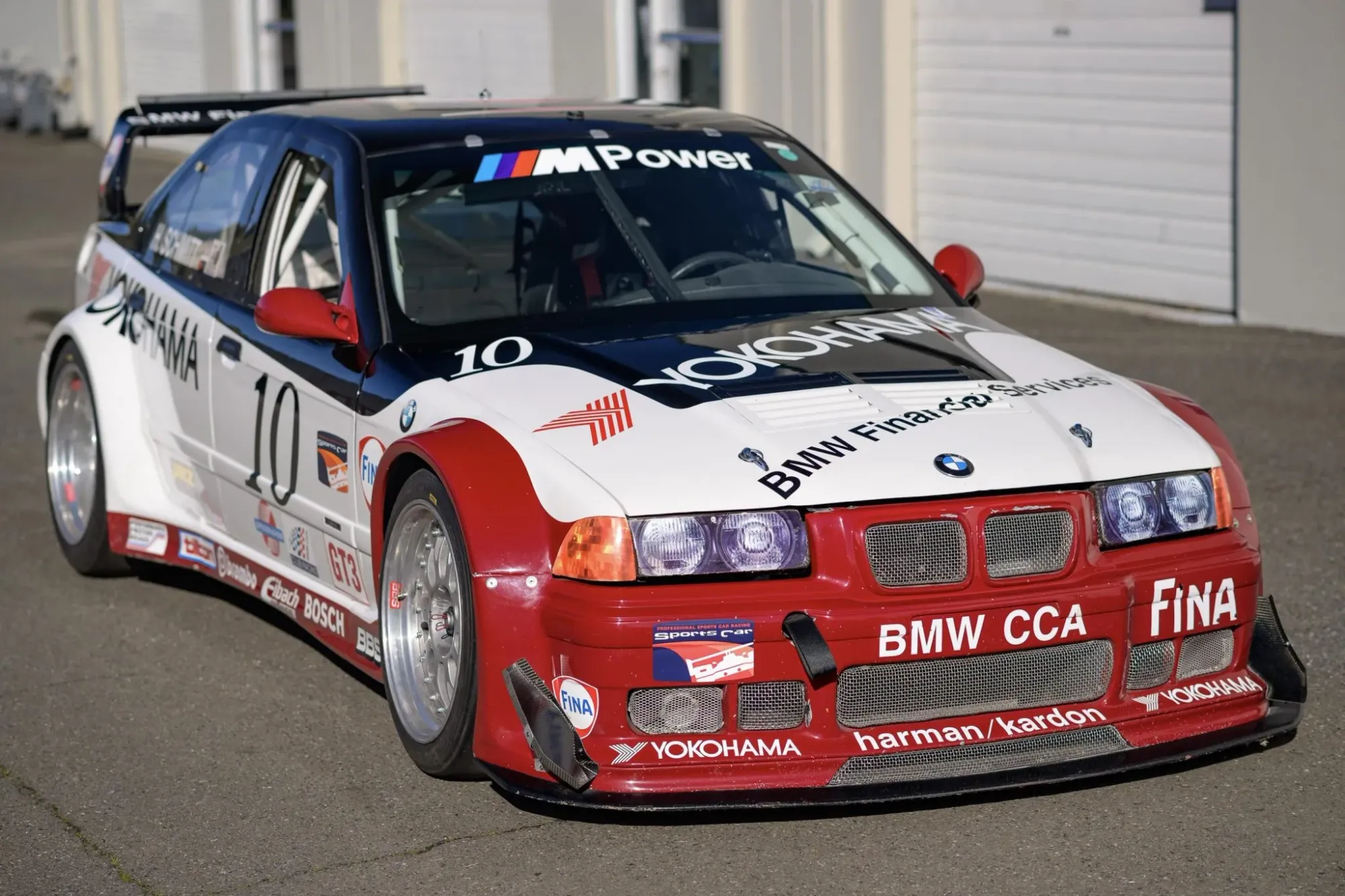
Front 3/4
Overall the aerodynamic considerations of the car look pretty solid, besides the aforementioned gaps. The hood vents are placed well, but could potentially benefit from a small gurney flap at the leading edge of the vent.
Were AeroCatches a thing back then?
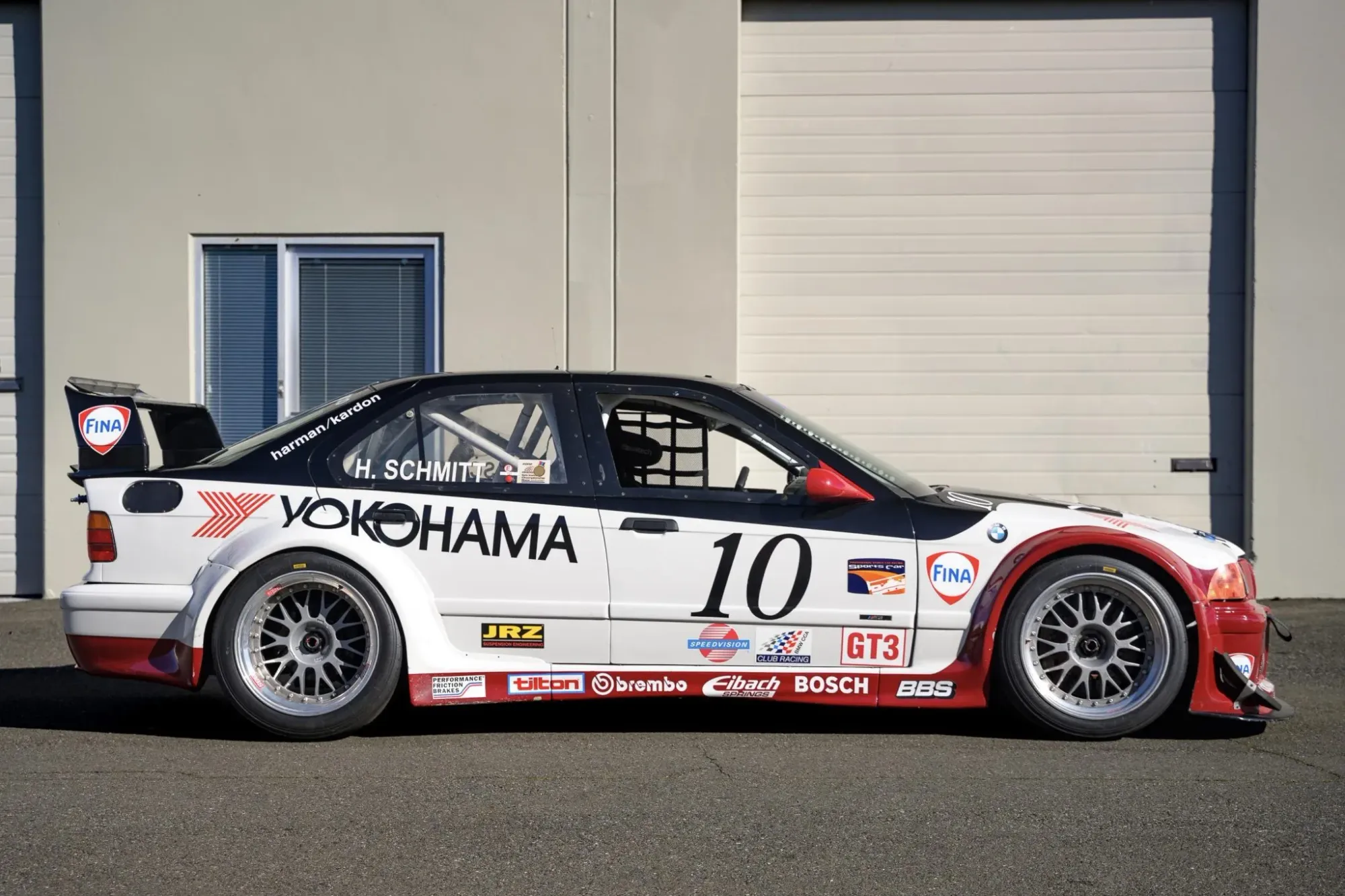
Side View
Why are the fender arches so... uneven? This always bothers me, especially on aftermarket fenders.
Otherwise, 10/10 side view. I've always loved the E36 sedans's high trunk lid profile.
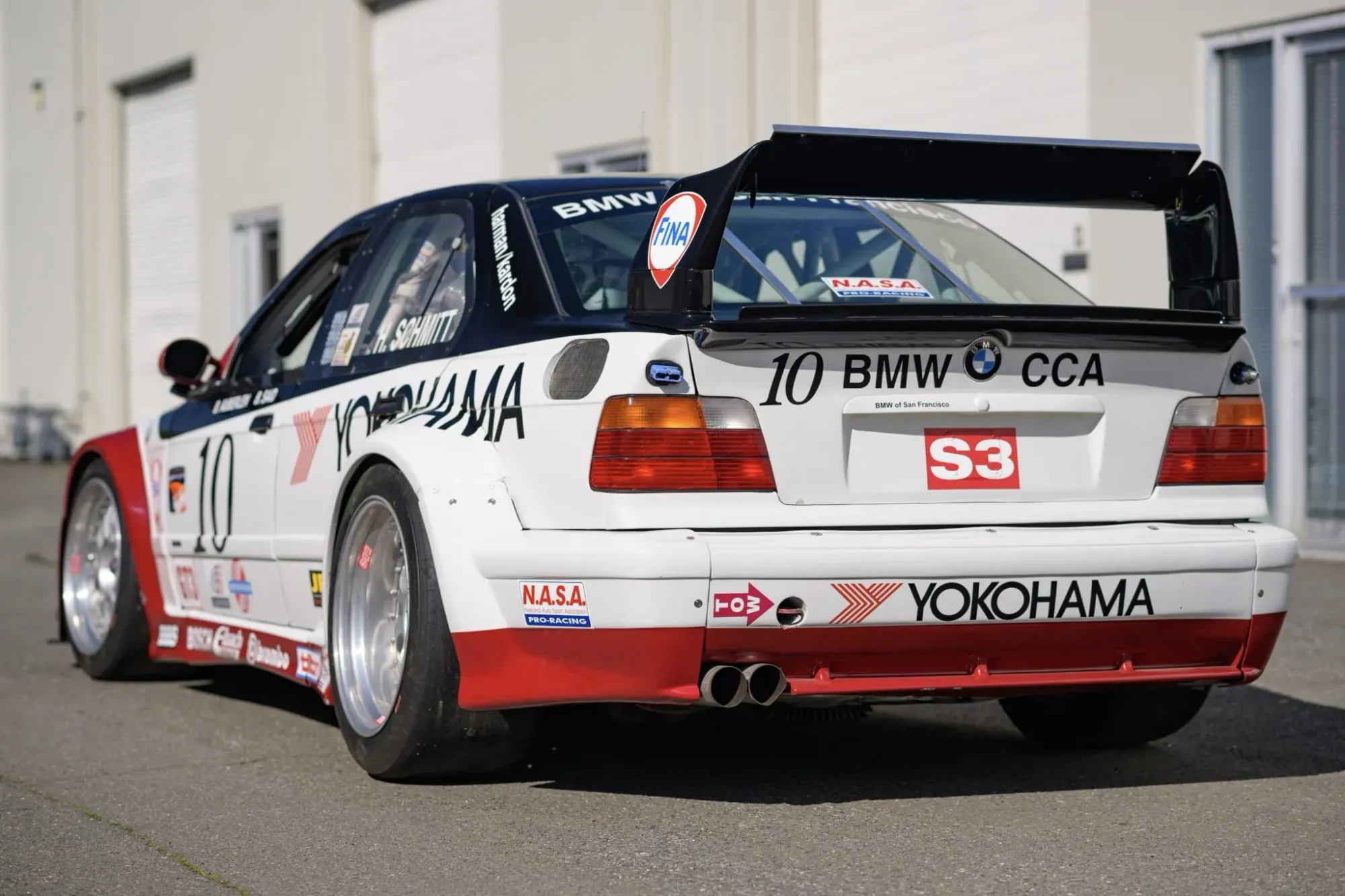
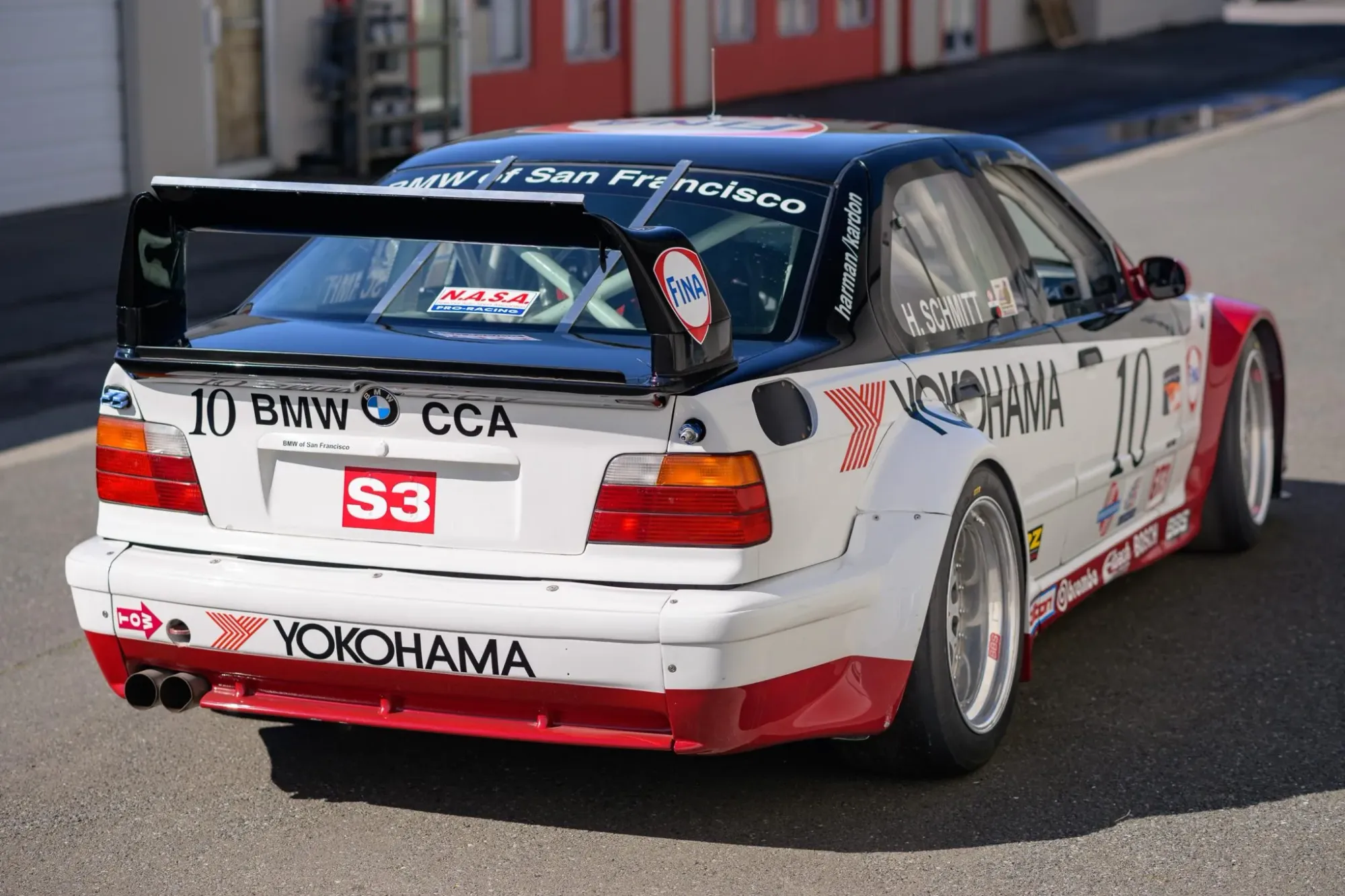
Rear 3/4
Mmm, pneumatic air jack port on the right. Some sort of data port on the left?
It looks like much of the bodywork is secured with DZUS fasteners. Probably for ease of repair and replacement.
There seems to be fuel doors on both sides of the car, but they are both riveted on. Not sure what's up with that.
There is a LOT going on with the rear spoiler. More on that later.
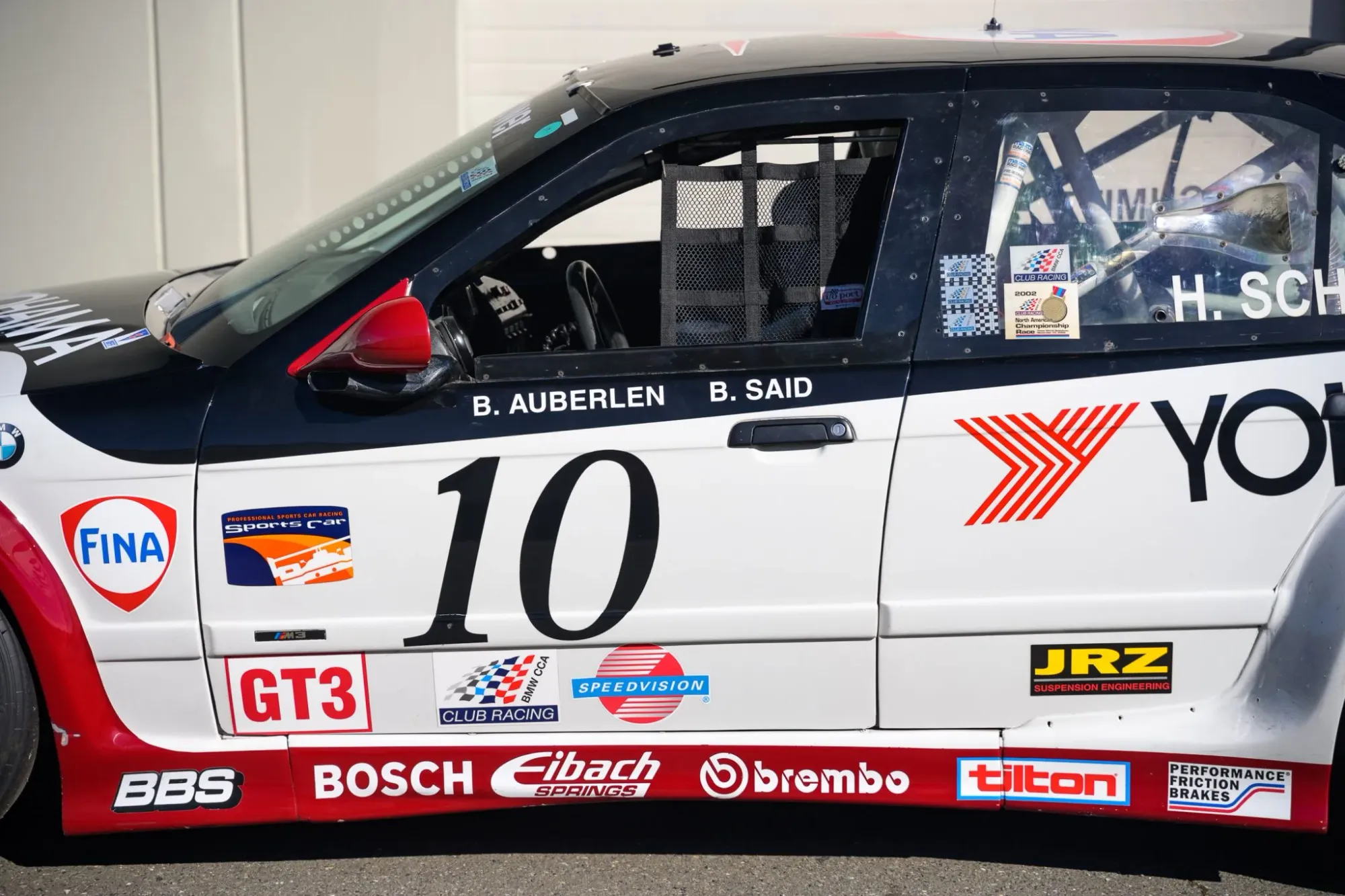
Driver's Door
I'd leave those names on it, too.
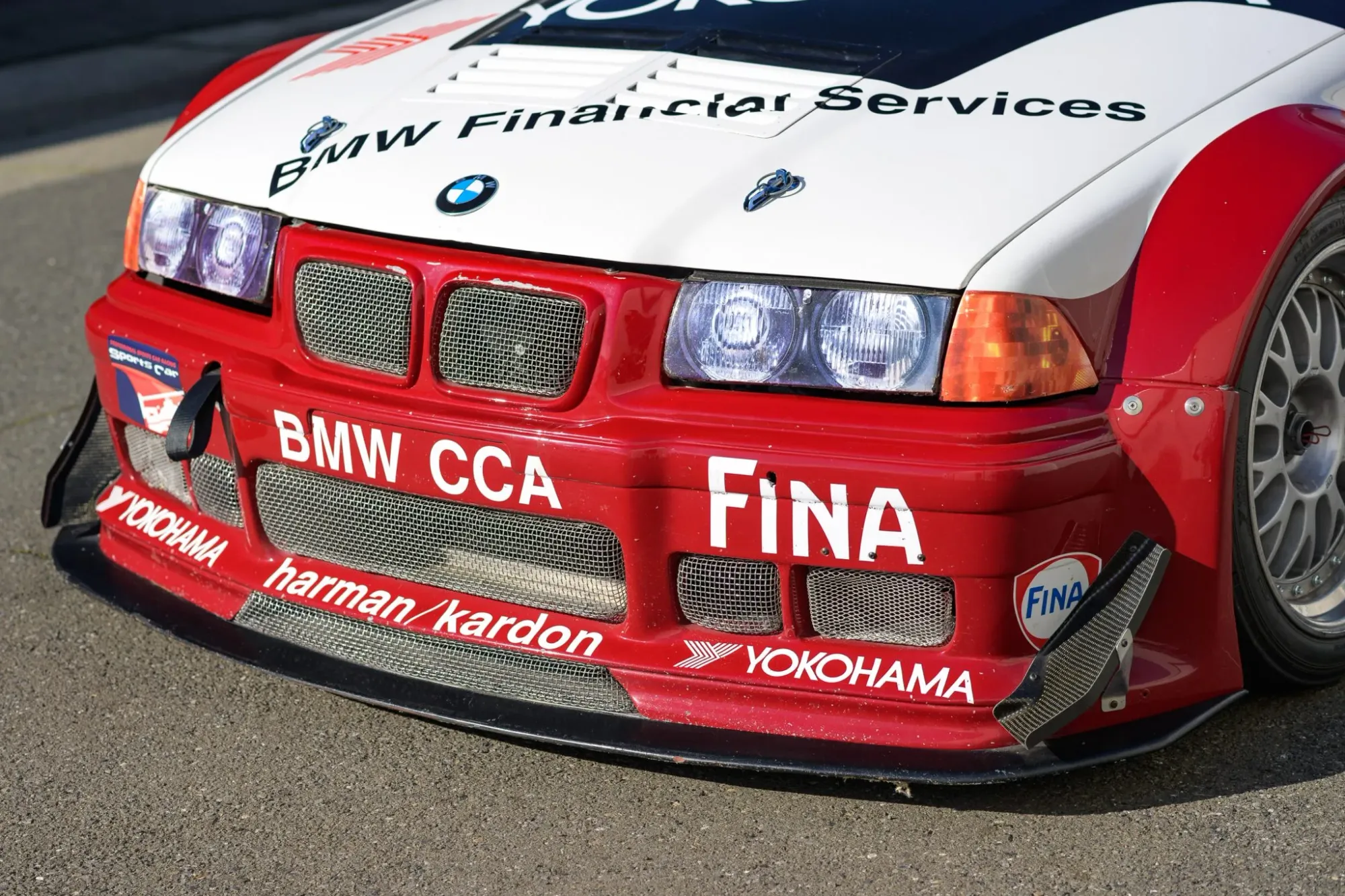
Front Closeup
Better view of the massive gaps. Some racer's tape could close those right up.
You can see some duct work for the radiator. My guess is that each side has brake ducts, plus some sort of scoop for the engine. Not sure what the opening above the splitter in the center is used for, as it looks separated from the radiator ducting.
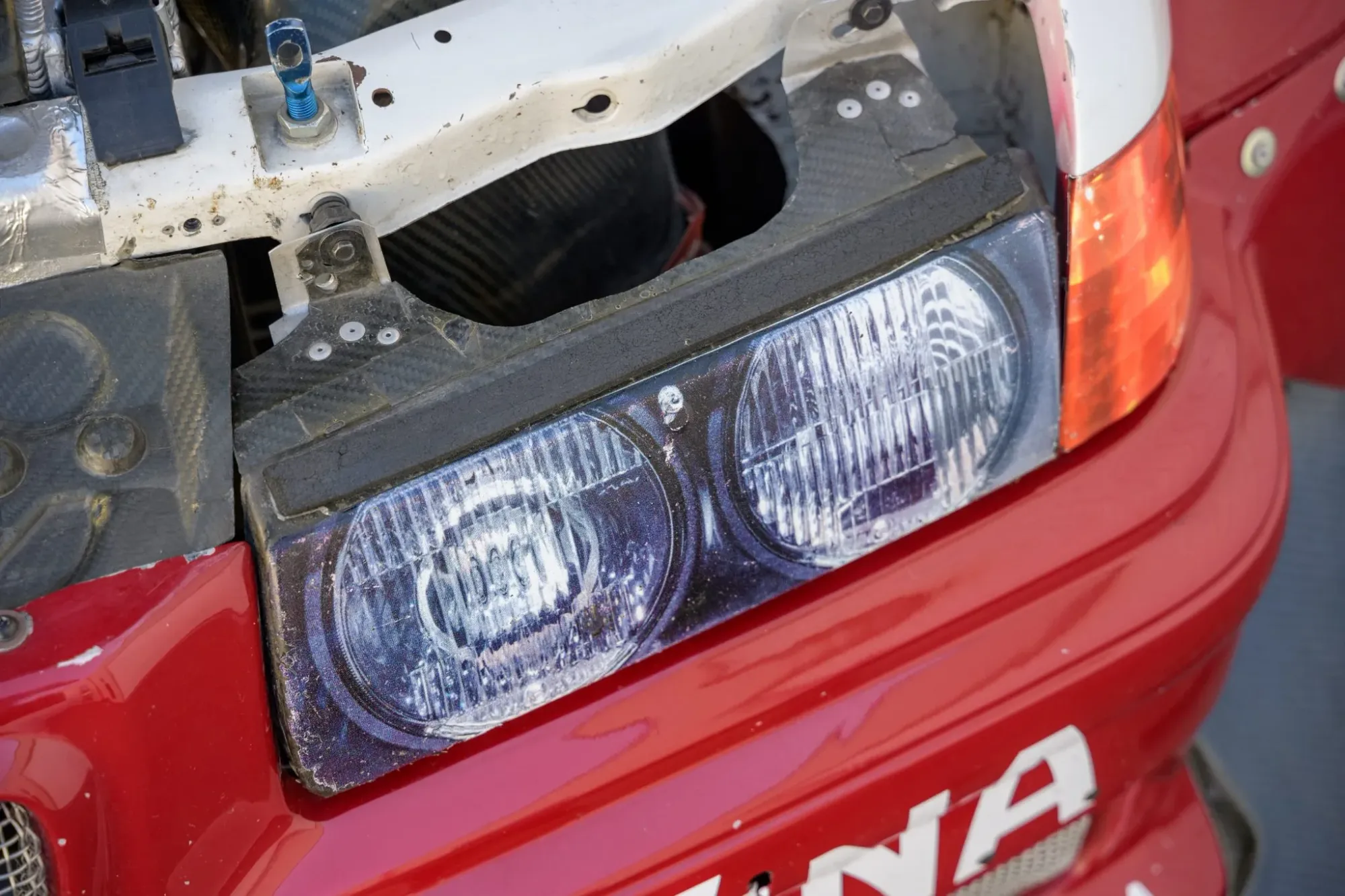
Headlight Closeup
There is a lot of dry carbon fiber on this car. A lot.
They cut and boxed the radiator support to strengthen where the hood latch pins attach. Pretty cool!
Still using the factory plastic radiator clips. Dope.
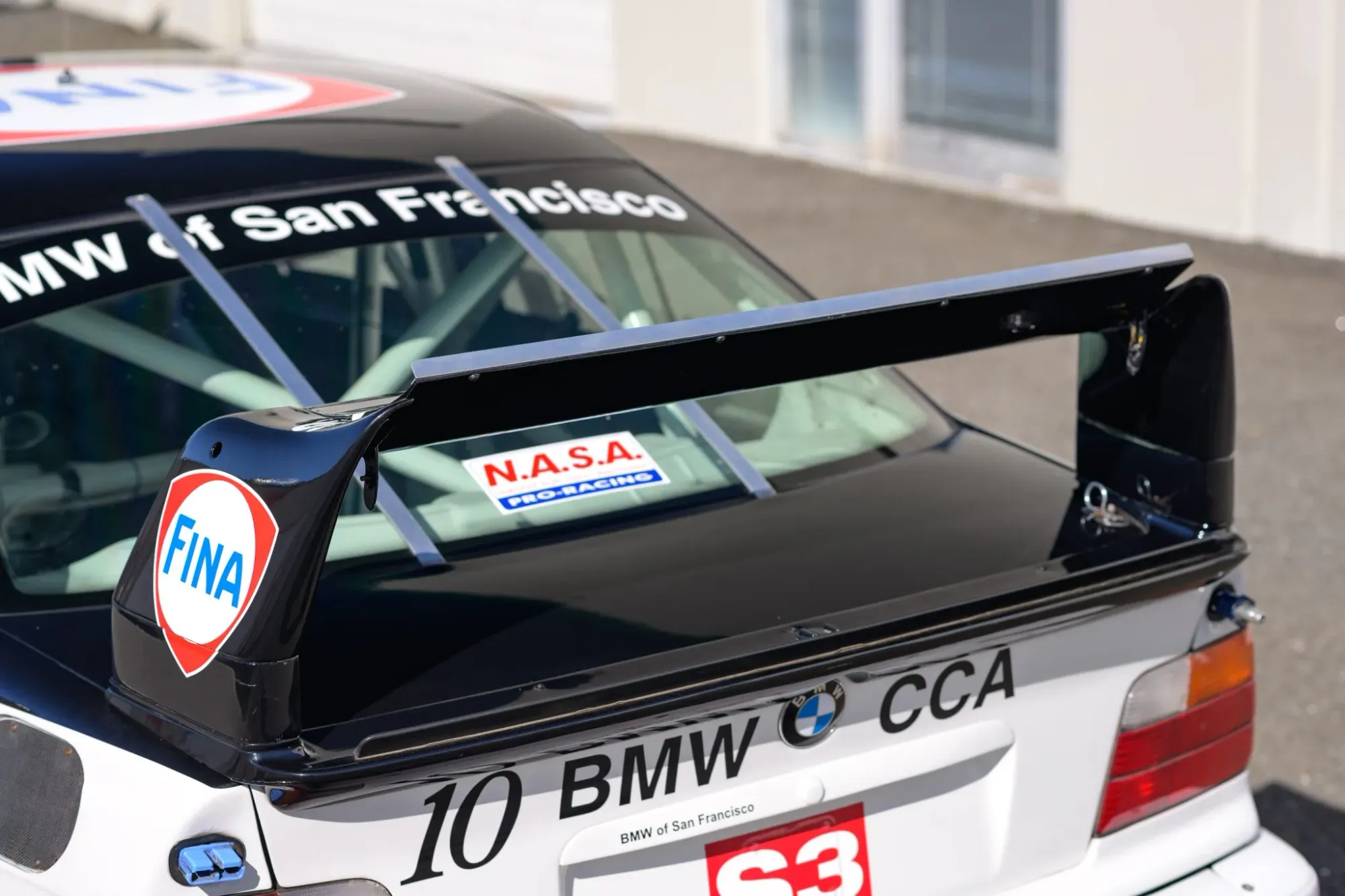
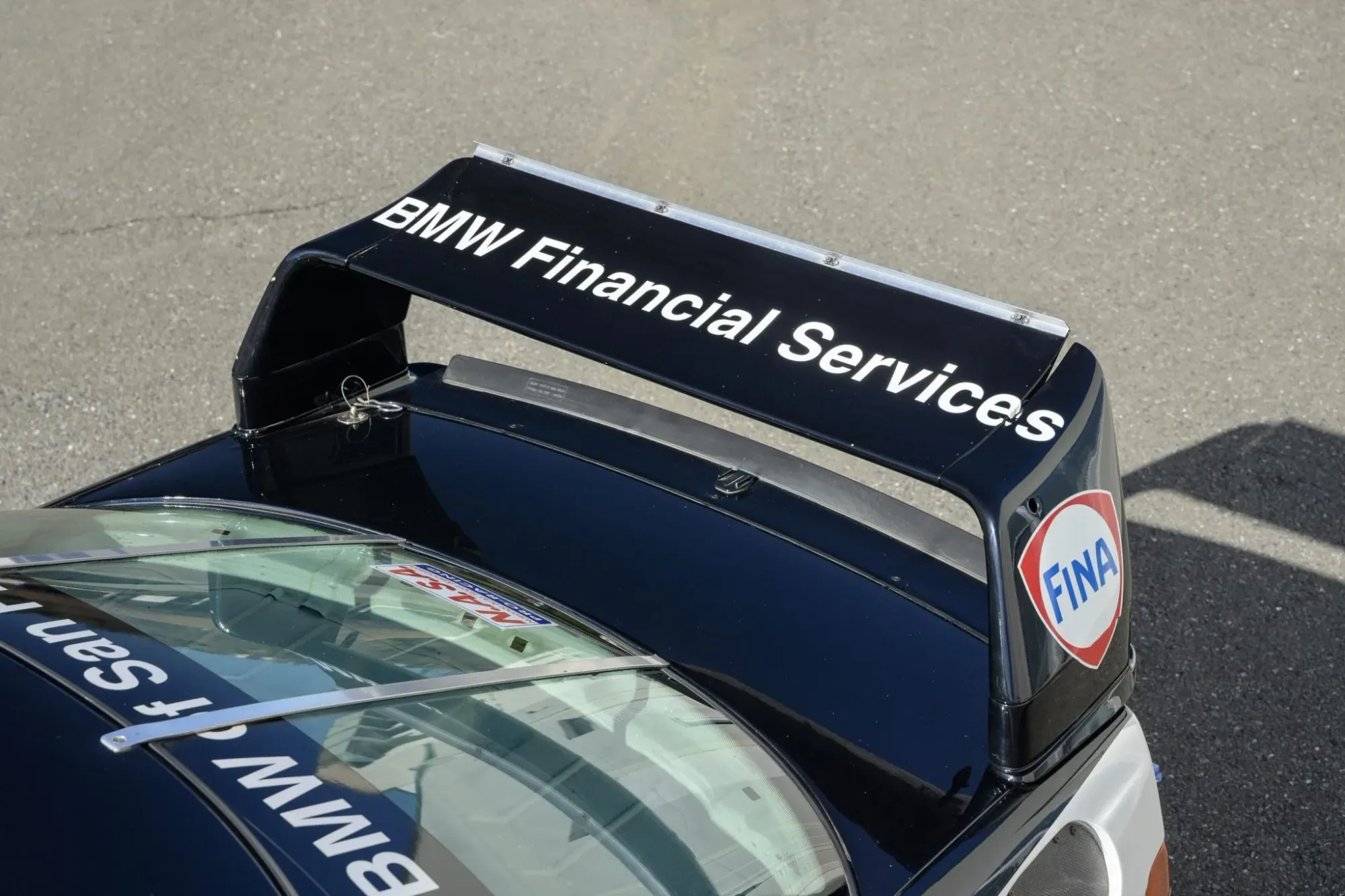
Rear Wing Closeup
This is a complicated setup! The PTG rear wing is loosely based on the E36 factory GT/LTW wing. While it has risers, the top portion itself is much higher, has more curvature, and it has an adjustable angle of attack in the center.
The cherries on top are a gurney flap added to the adjustable center segment, and another small spoiler on top of the integrated spoiler of the base. Spoilers on spoilers on spoilers.
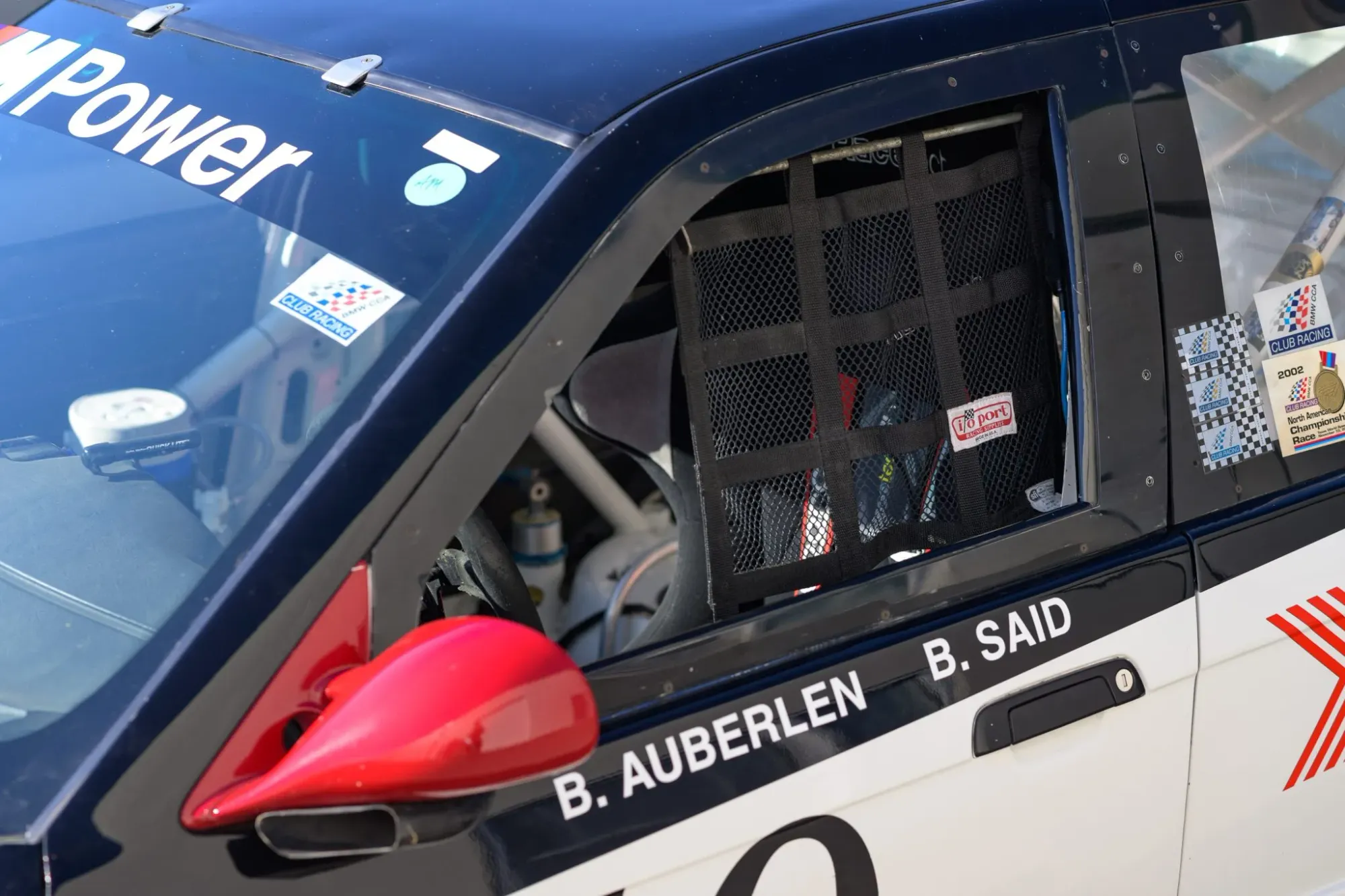
Driver's Window Closeup
The trim around the window frame is very nice looking. Notice the air intake scoop underneath the mirror, as well as the center vent in the mirror. I didn't know they made E36 M3 mirrors with the center vent (it was an E30 M3 DTM mirror thing) – that could be a custom PTG piece.
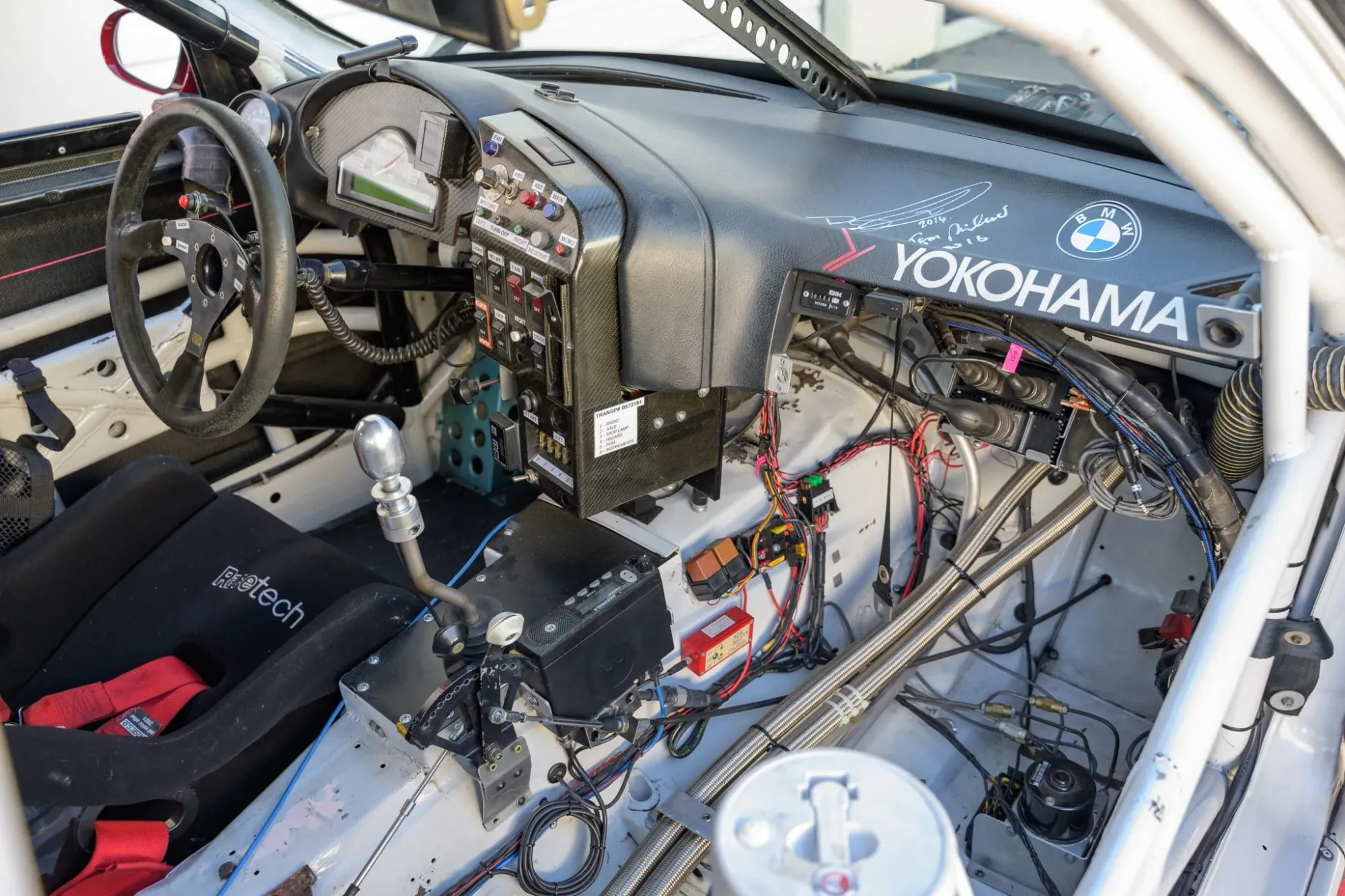
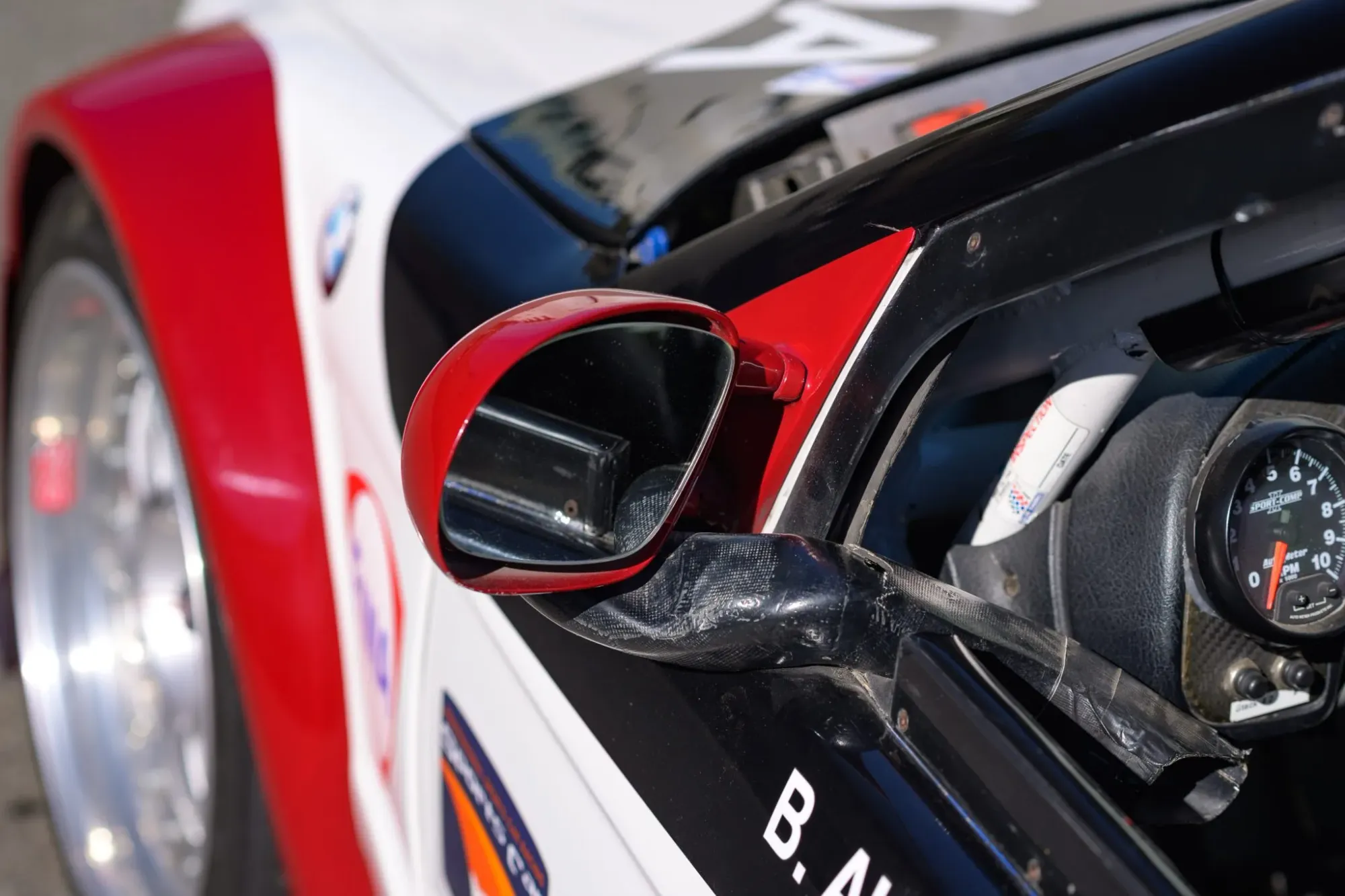
Vents Take 2
In these photos we can see that the carbon scoop under the mirror is for driver cooling. On the passenger side, the vent in the center mirror has tubing attached to it, but it's not clear where it goes to. Perhaps a windshield defogger setup, or to cool the electronics?
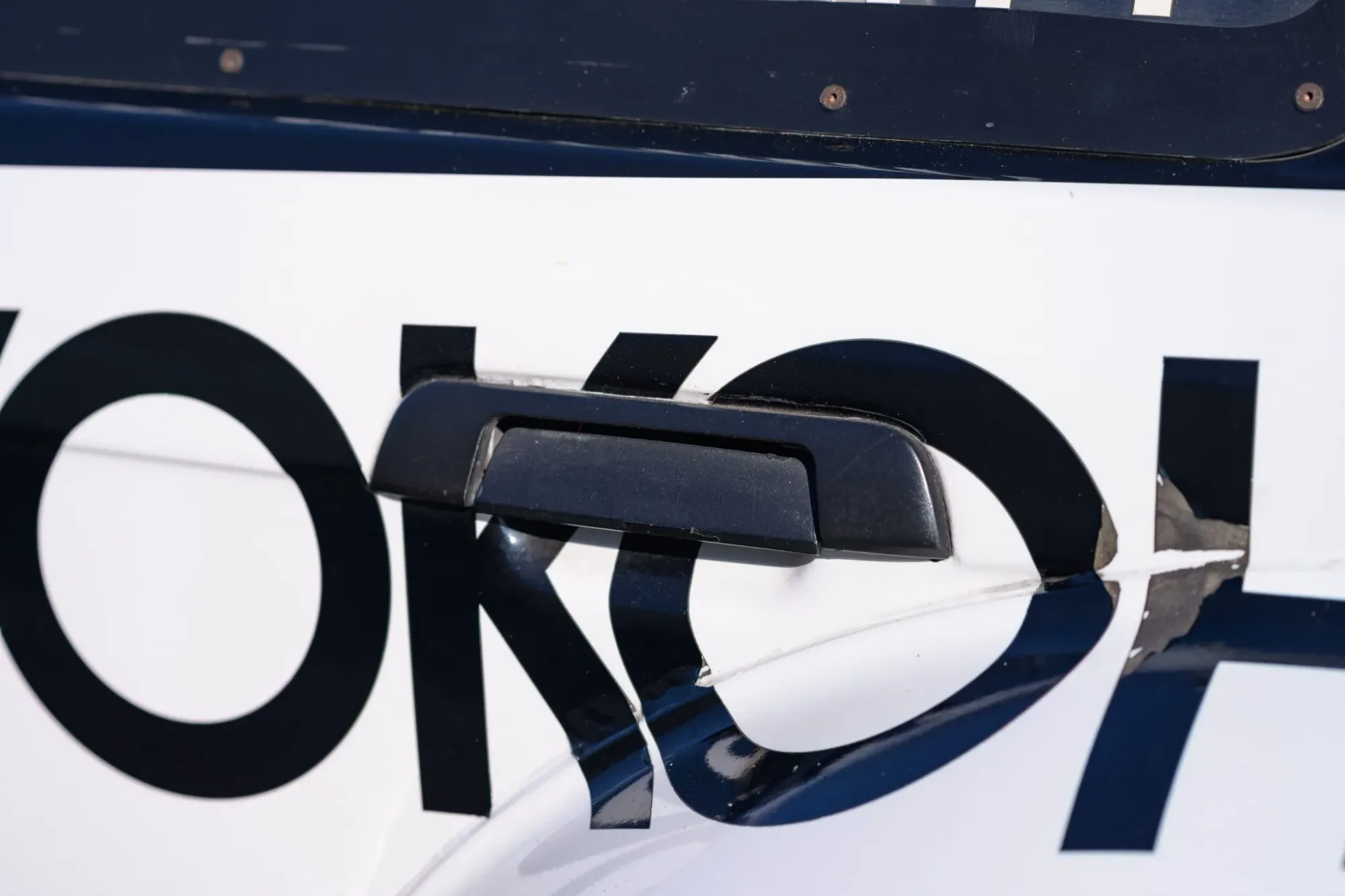
Door Handles
It gives me a little bit of pleasure knowing that two of the four door handles are broken on this multi-hundred thousand dollar car. E36 door handles suck.
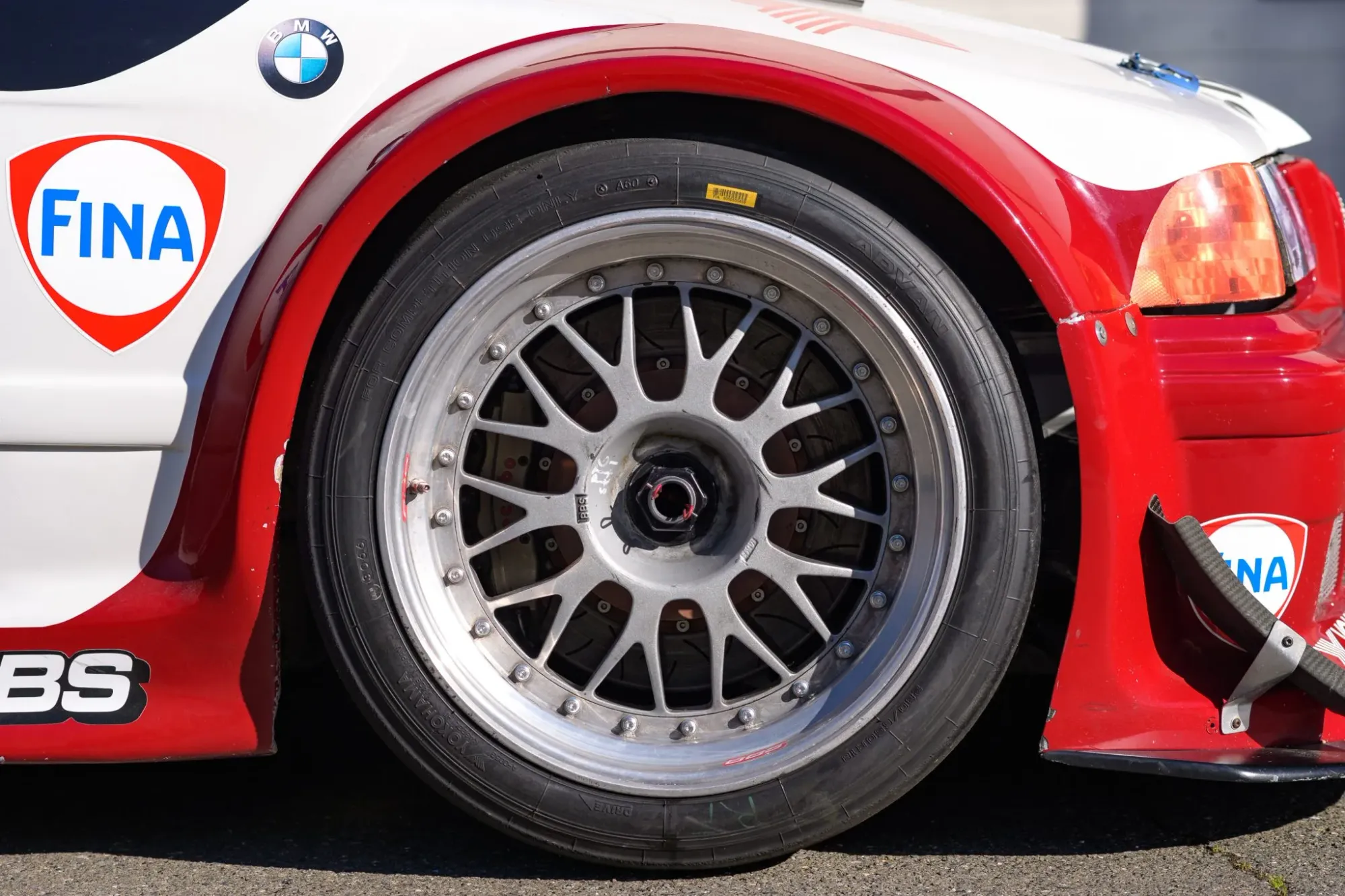
Wheel Closeup
Large multi-piece BBS centerlocks all around. They are 18". The front tires are 280/650-18 and the rears are 280/680-18 (the same width, but even taller). Brembo 6-pots up front and 4-pots in the rear.
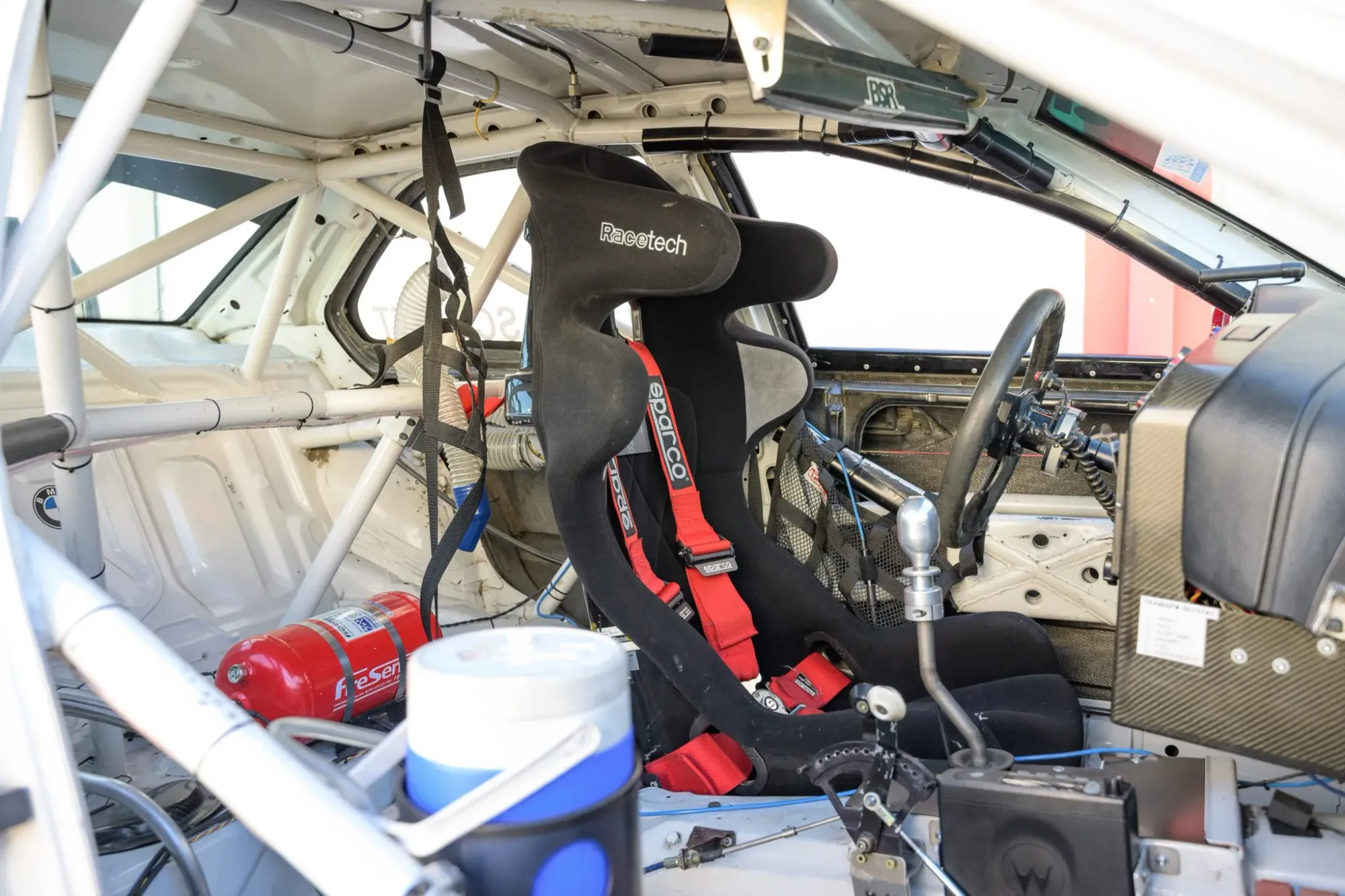
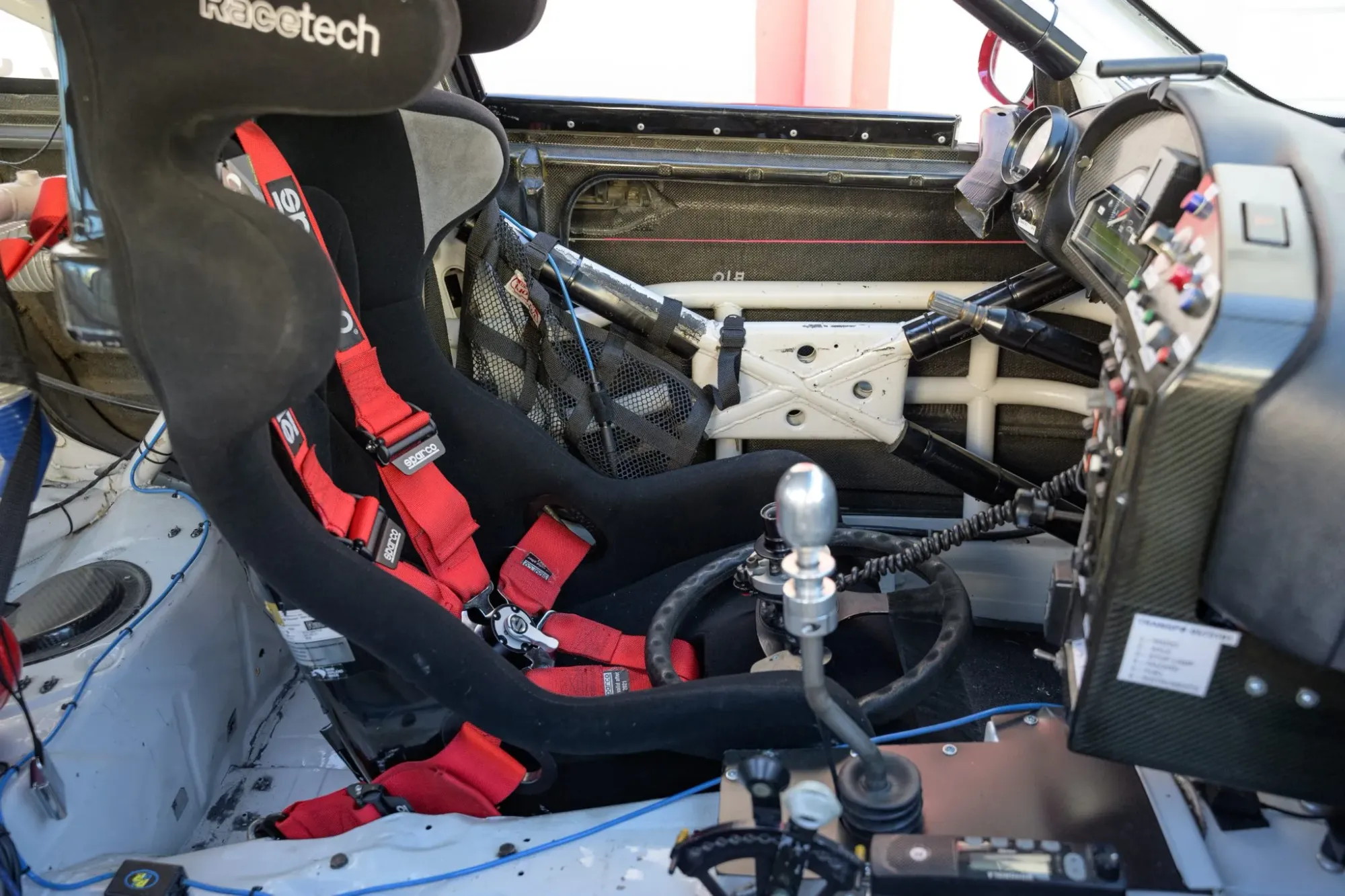
Roll Cage Design
The roll cage is amongst the most interesting aspects of this car. It has a "double main hoop" design that originated in the 1992 E30 M3 DTM cars. The cage extends back to the C-pillar, which was really only a thing in the '90s. The E36 STW cars were mostly the same. By the time the E46 rolled around, they moved back to a more conventional design with only the B-pillar main hoop.
There is no conventional bracing of the main B-pillar hoop. Instead you can see downbars heading towards the rear subframe, and harness bars that triangulate those downbars.
It's possible that those bars were not even used as harness bars to begin with. In that era, the belts were often attached to the rear parcel shelf – very far back behind the driver, and sometimes at odd angles. Nowadays, harnesses are attached close to the driver, and level to, or slightly below the driver's shoulders.
Also of note is the double door bar design on the driver's side door. It has a kicked out NASCAR bar, as well as a heavily gusseted straight X design. Super strong setup with a lot of intrusion protection.
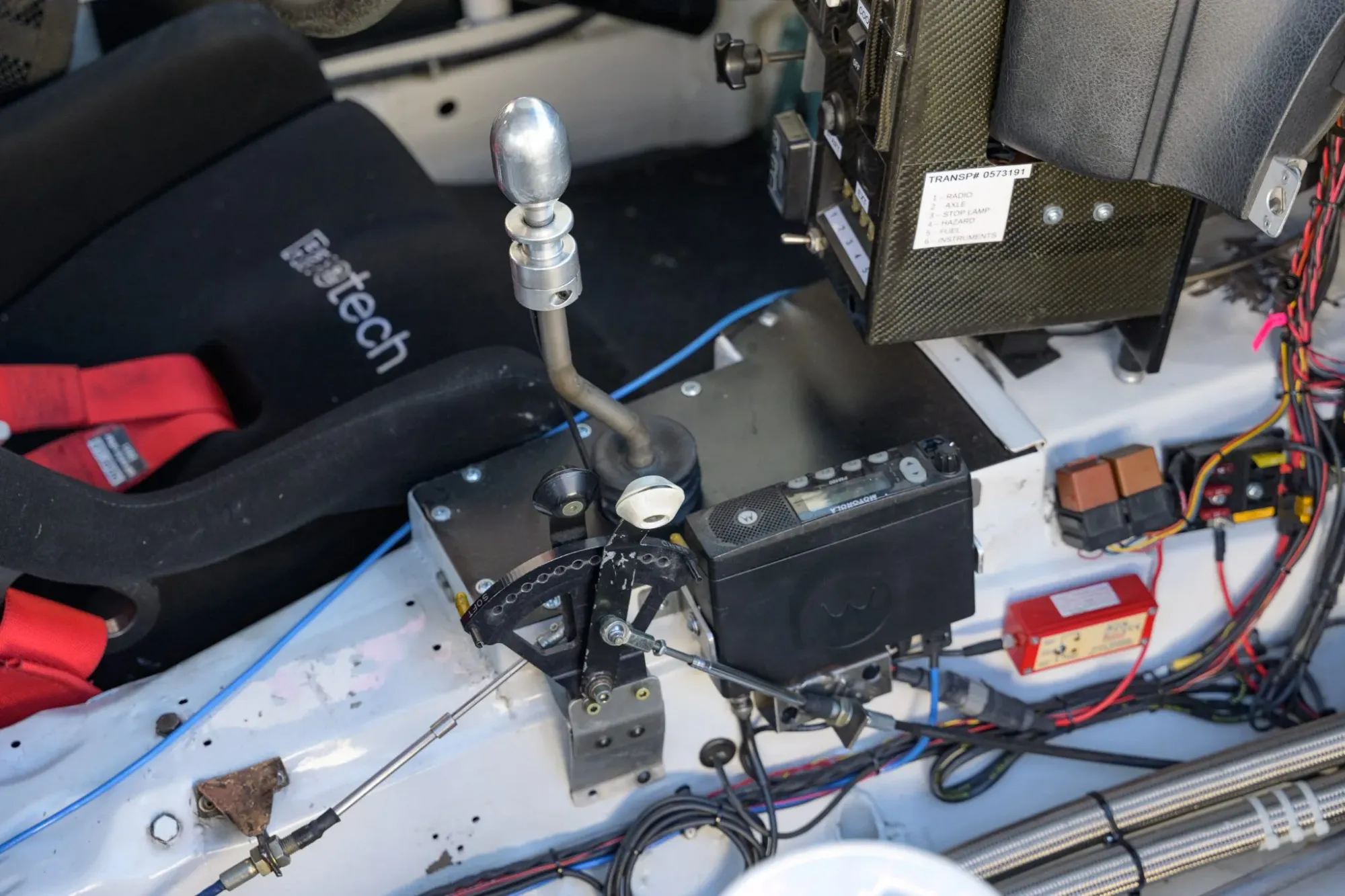
Center Console Closeup
Here you can see that the transmission tunnel was modified for the sequential gearbox and shifter assembly. The car now sports an Elite IL300 six speed sequential, but in the comment section it is noted that the car originally had a Hewland or Holinger transmission. It is not clear if the original transmission was a sequential, or an H-pattern dog box.
You can also see here the mechanical sway bar adjustment levers. These look very similar, if not the same, as what was used on the E30 M3 DTM cars. Left side is the rear bar, and right side is the front bar.
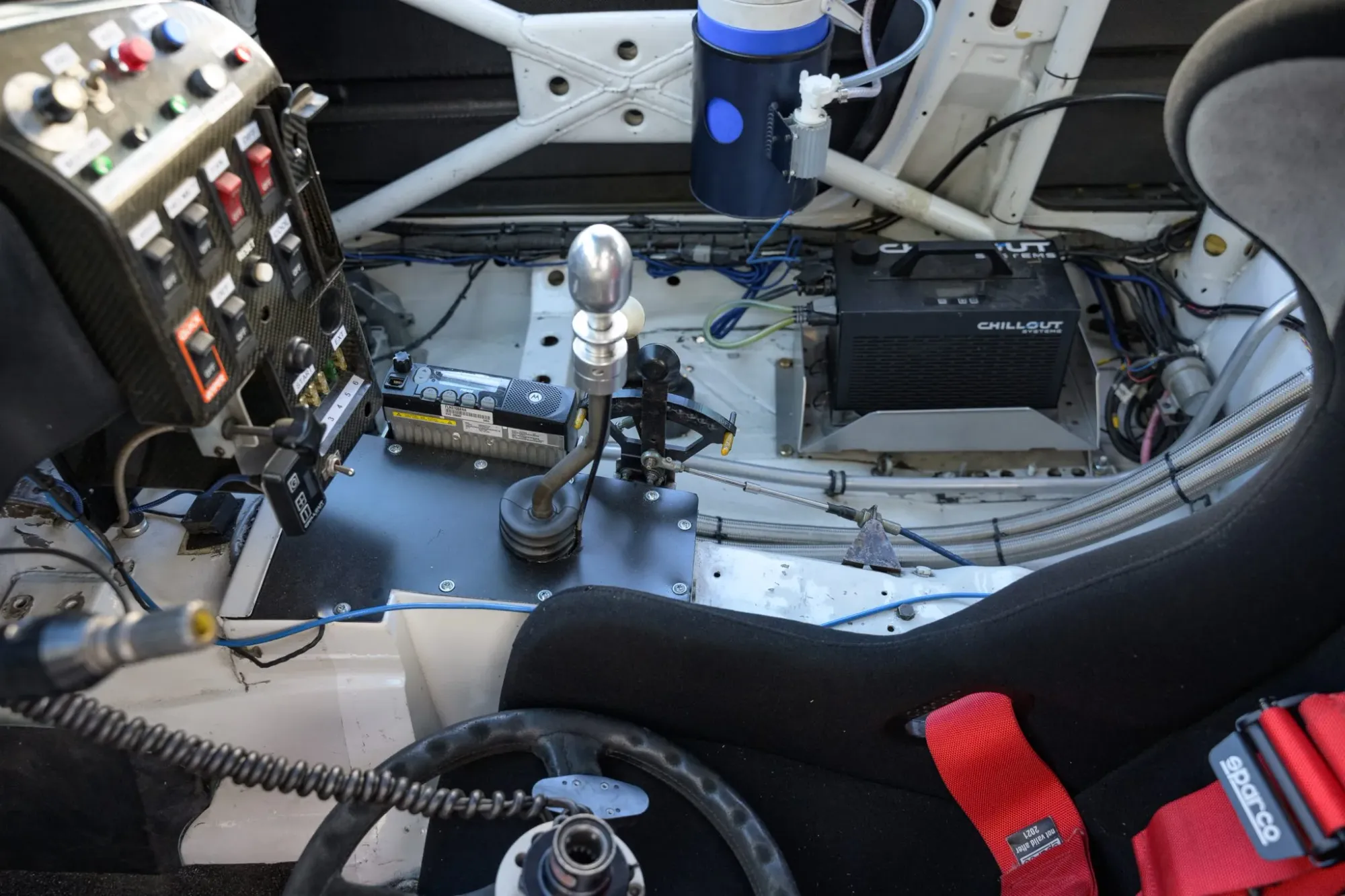
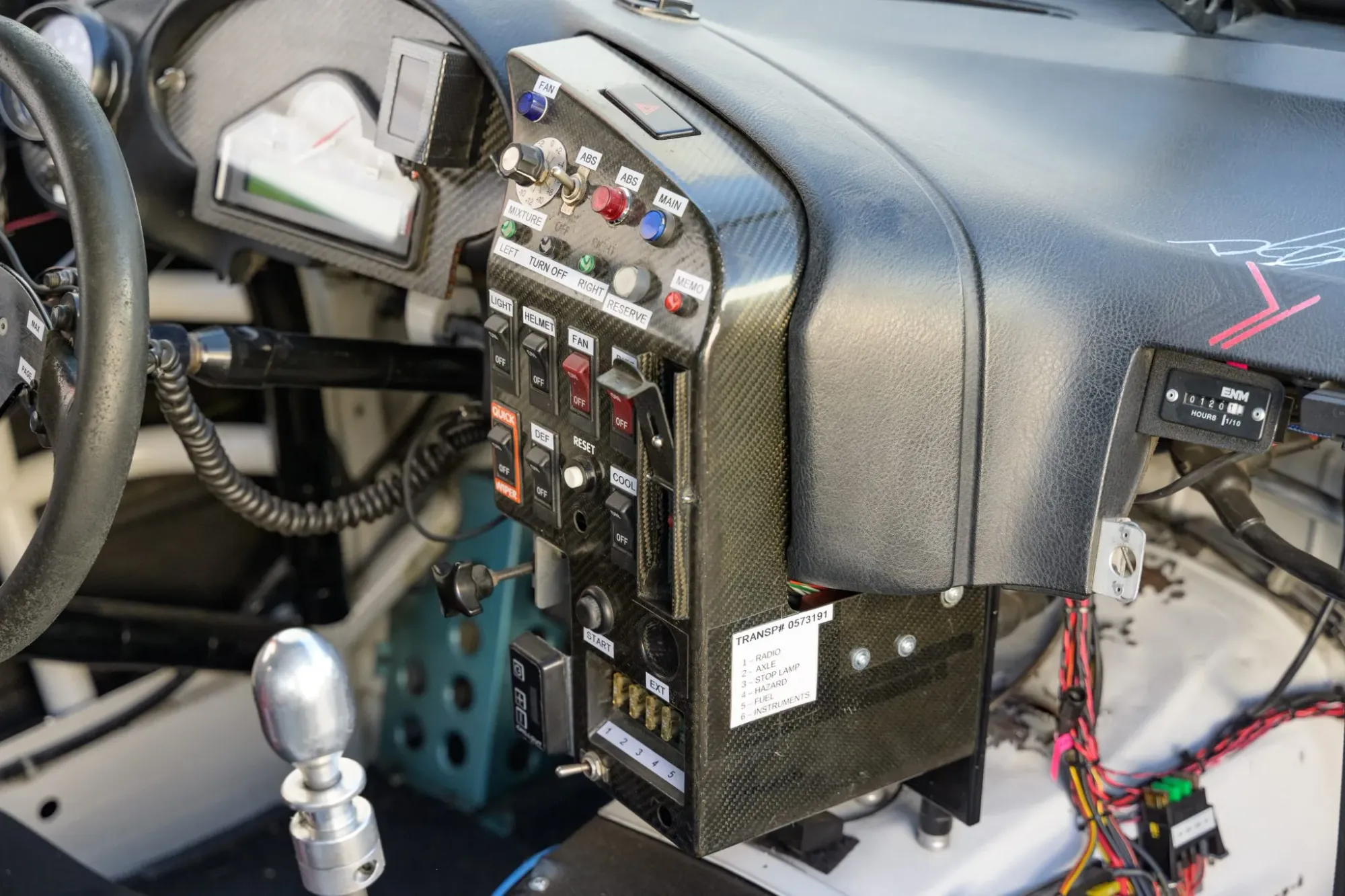
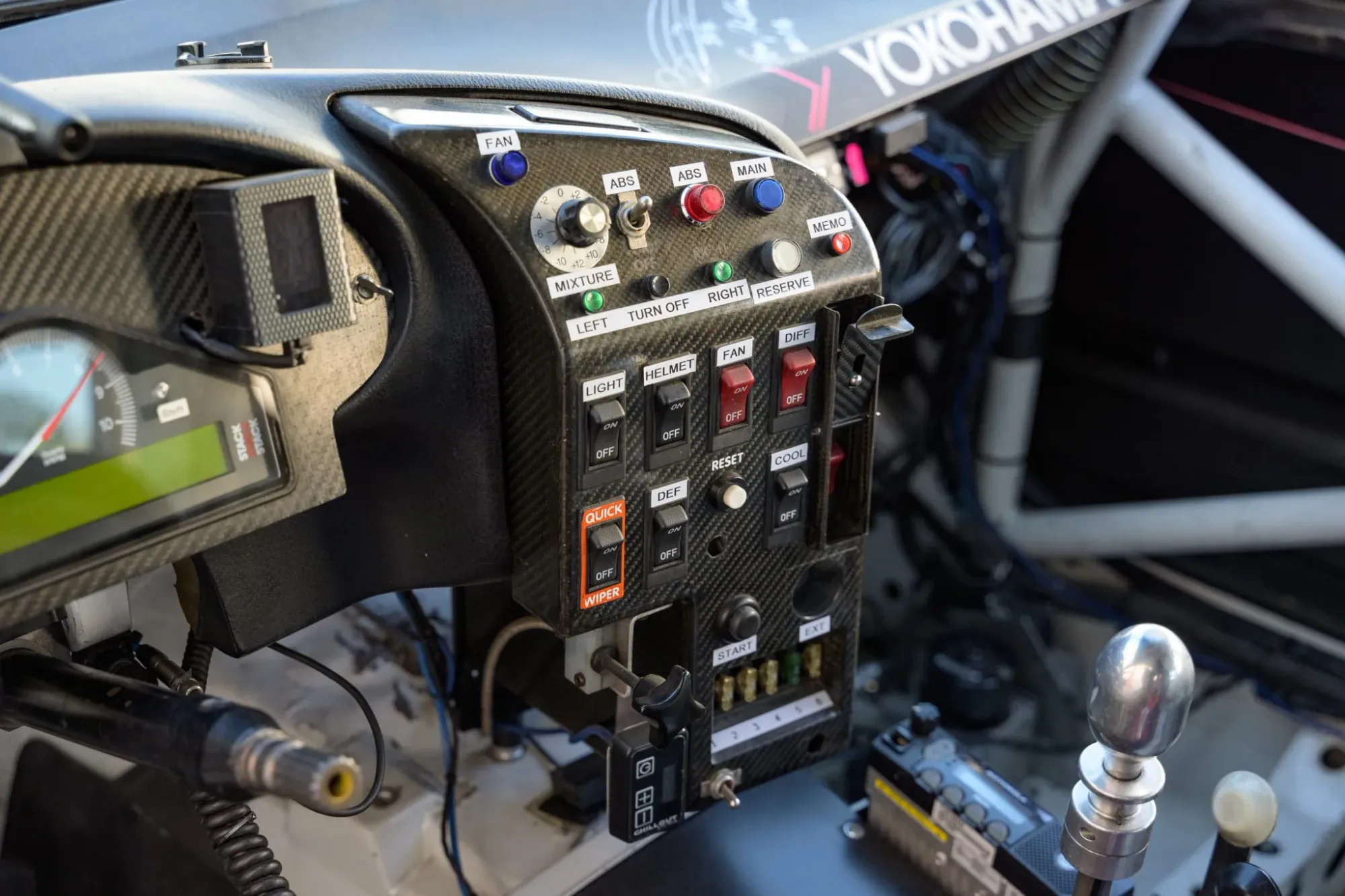
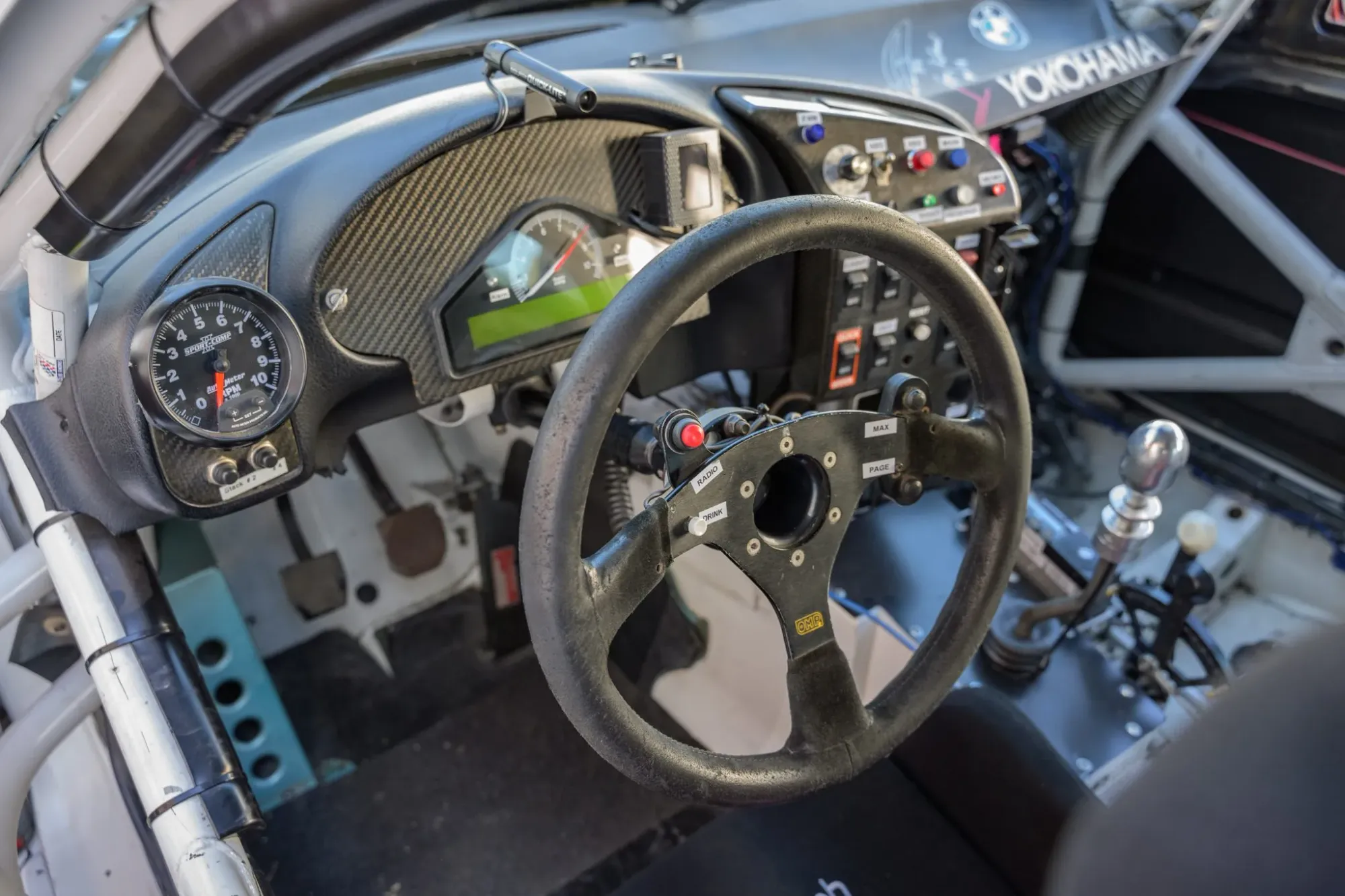
Interior Details
The stock dash shape is retained; it might even be a factory dash. The center control panel is a great looking carbon fiber piece, with some interesting details.
It is not mentioned what engine management system is in the car, but you can alter the air/fuel ratio by twisting a knob.
There are basic toggle switches which are pretty self-explanatory. There is a gear indicator for the sequential. You can turn the ABS on and off, and there are switches for some of the various coolers, including a differential cooler.
The Quantum Chillout System was certainly added to the car later in life.
The drink system has a pump to shoot water into the driver's mouth, and it seems like the car had a helmet cooler and a traditional "cool shirt" ice box system in an earlier life.
You can see large braided steel lines running to the back of the car for the 3.4L engine's dry sump system.
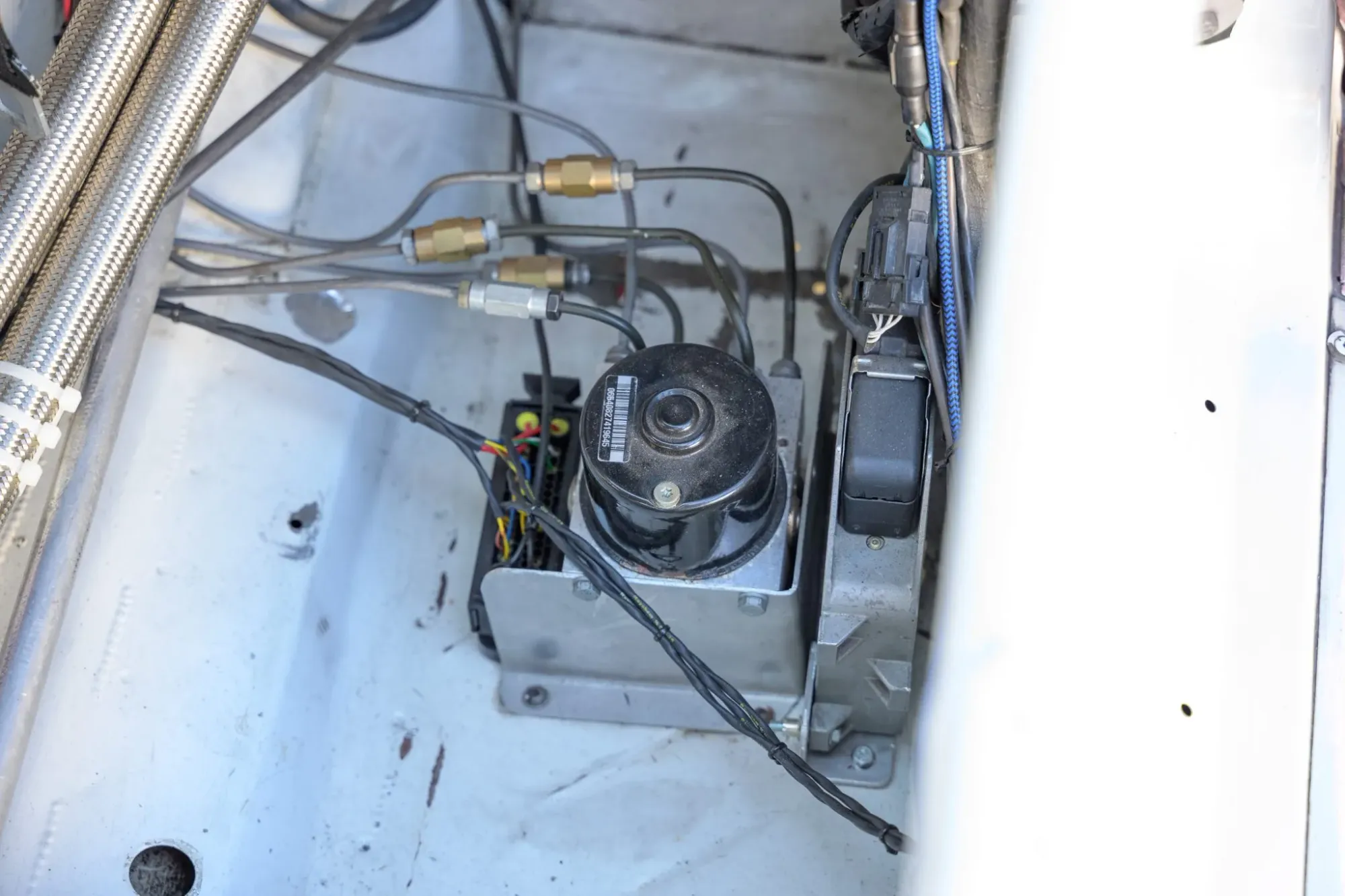
Passenger's Floor Pan
The ABS pump is inside the cabin on the passenger's floor pan. I imagine the relocation is for better weight distribution. Usually the factory ABS pump is on the driver's side and at the front of the car, typically worst spot to have extra weight on a production RWD, front-engine car.
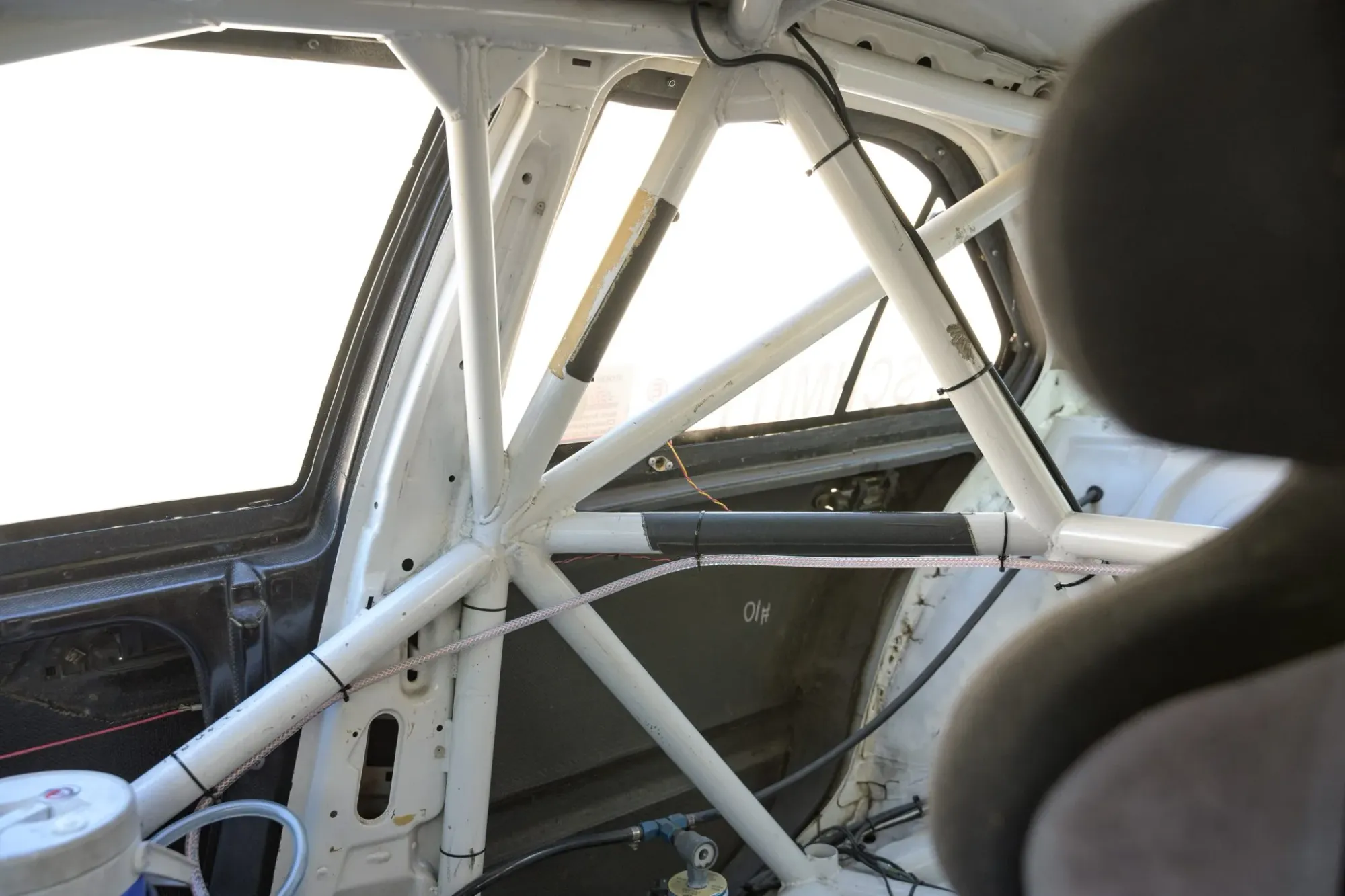
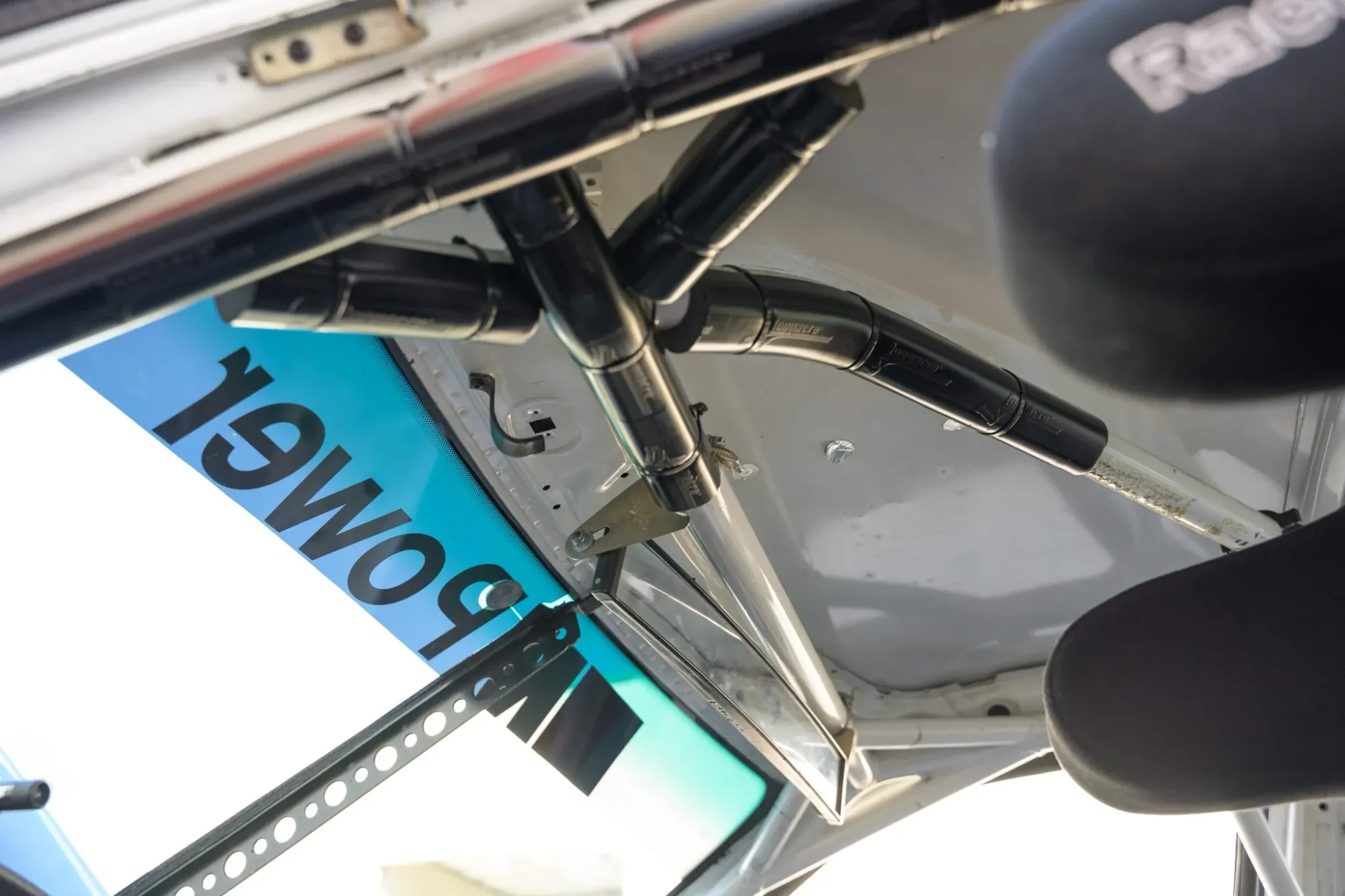
More Roll Cage Details
Those photos show the excellent use of nodes on the roll cage. The use of nodes is always desirable, when practical, to create load paths for each bar. This is an under-looked aspect of roll cage design, in my opinion.
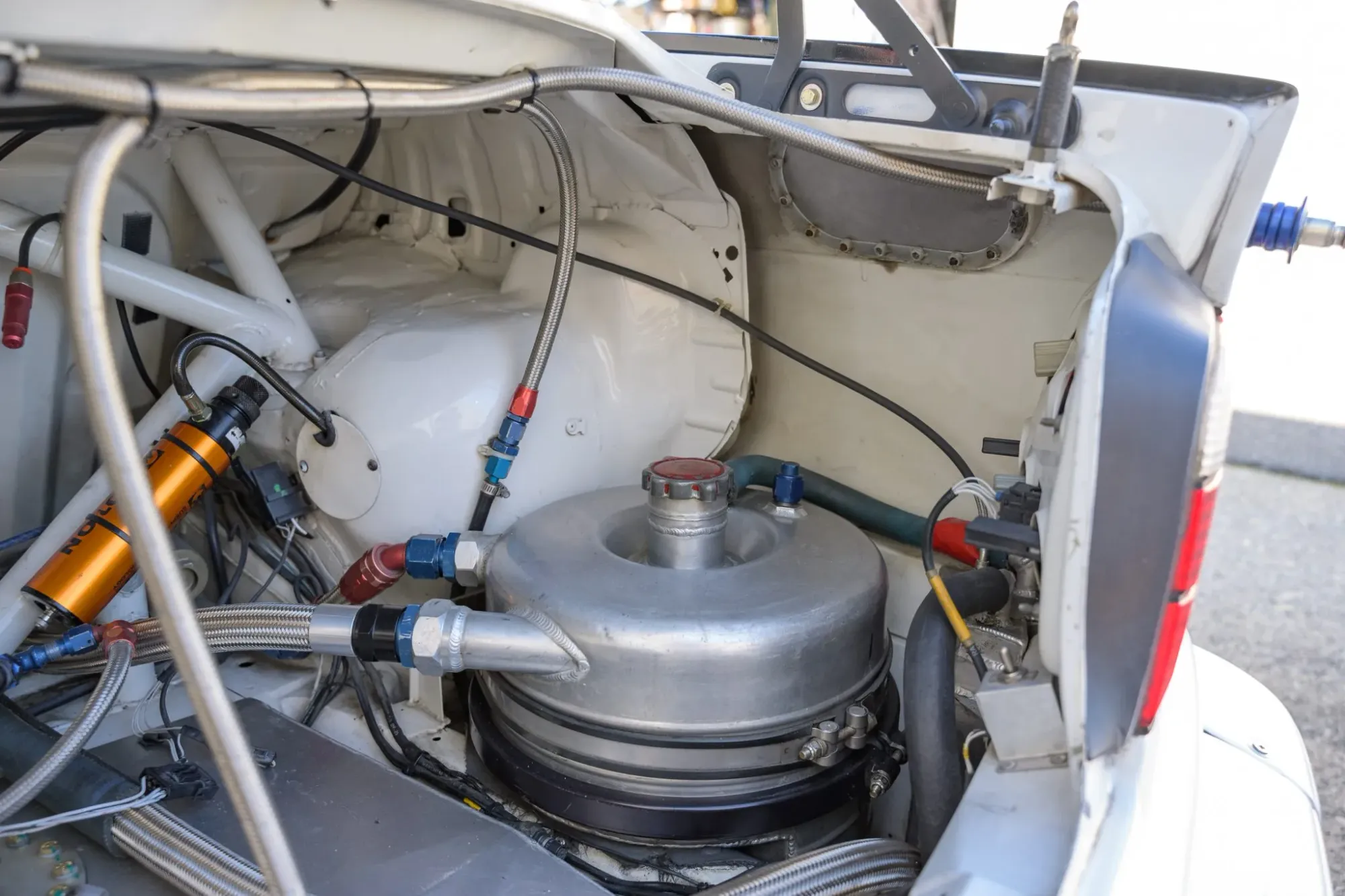
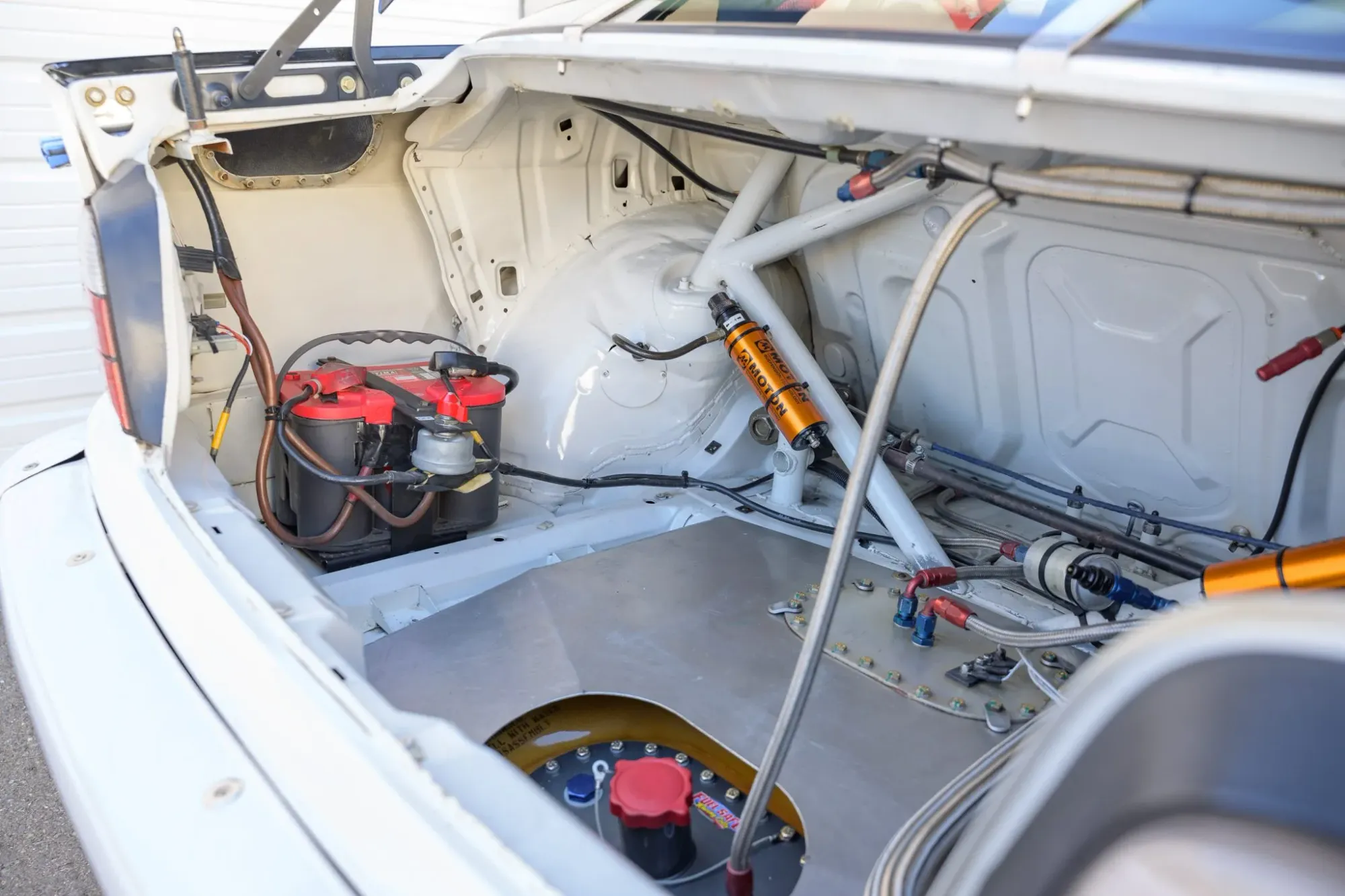
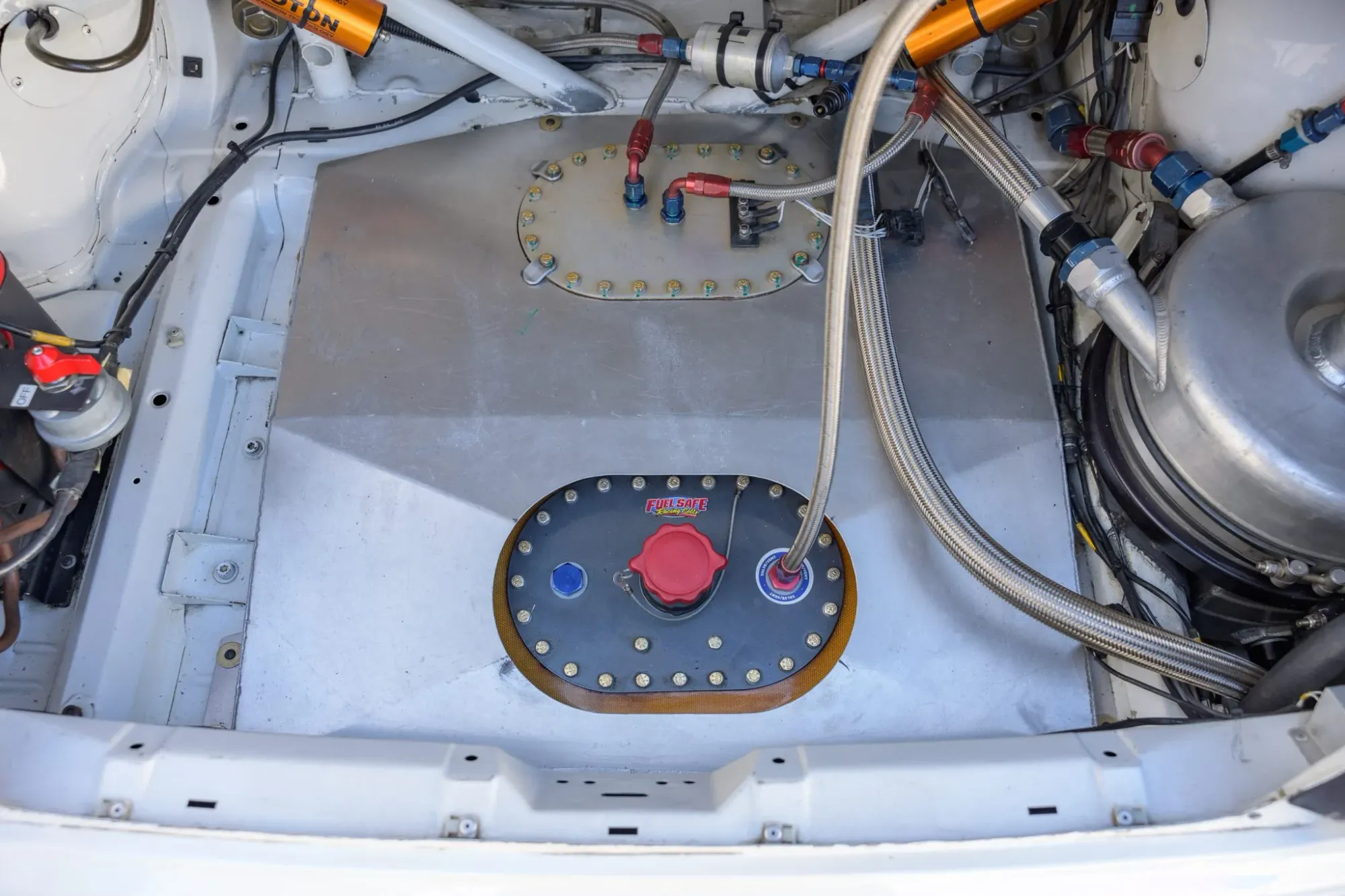
Trunk Area
That's one busy trunk!
The battery has been relocated to the driver's side, and the dry sump tank sits on the passenger's side. A large fuel cell and the associated plumbing and pumps are in the center. Moton remote reservoir cannisters are mounted to the cage.
The cage downbars terminate on the rear shock towers, and are triangulated down to the rear subframe.
We see here that the "data port" on the passenger's side rear quarter panel is actually connected to the battery, so it's a connector for a battery charger/tender.
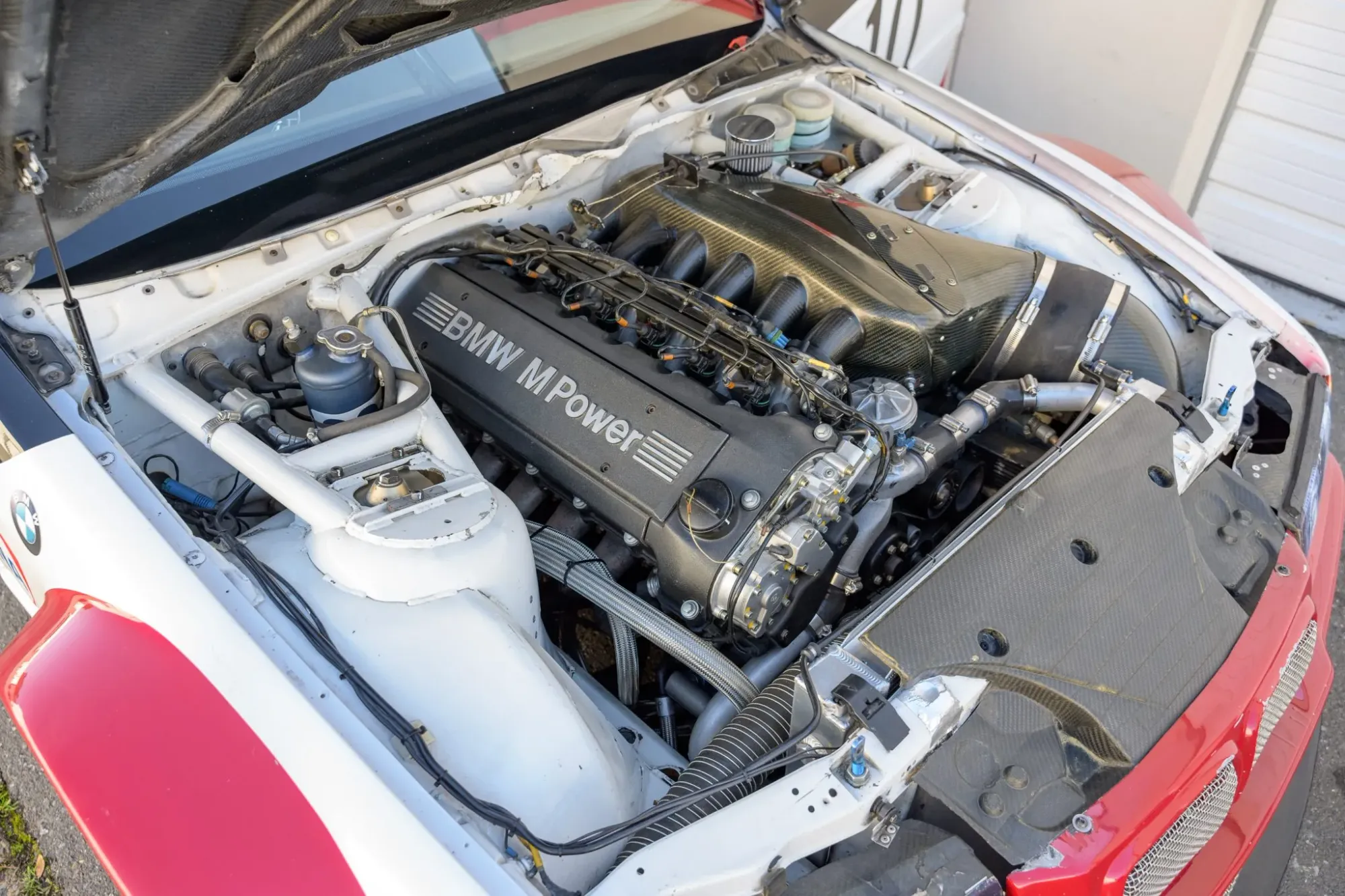
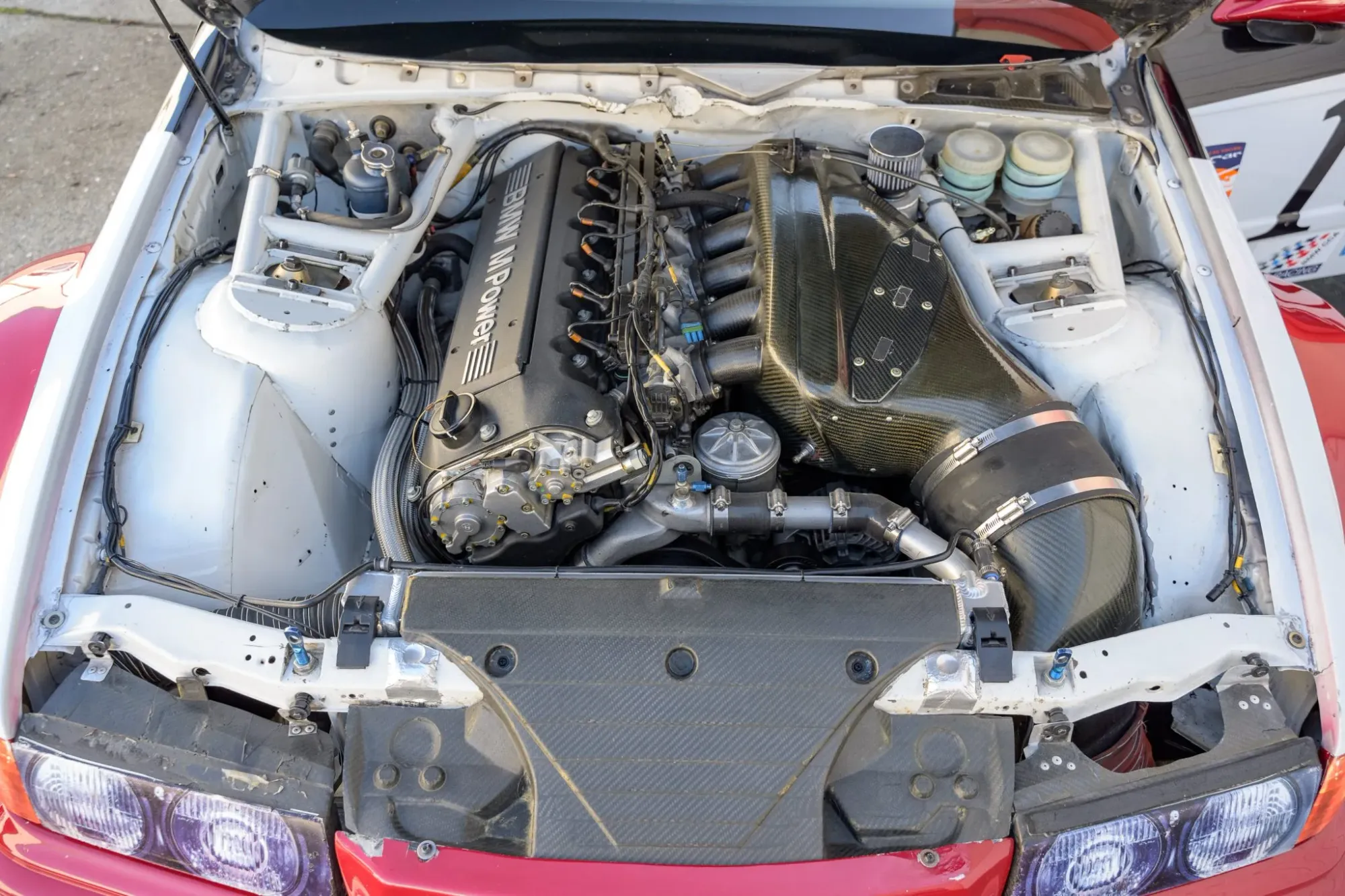
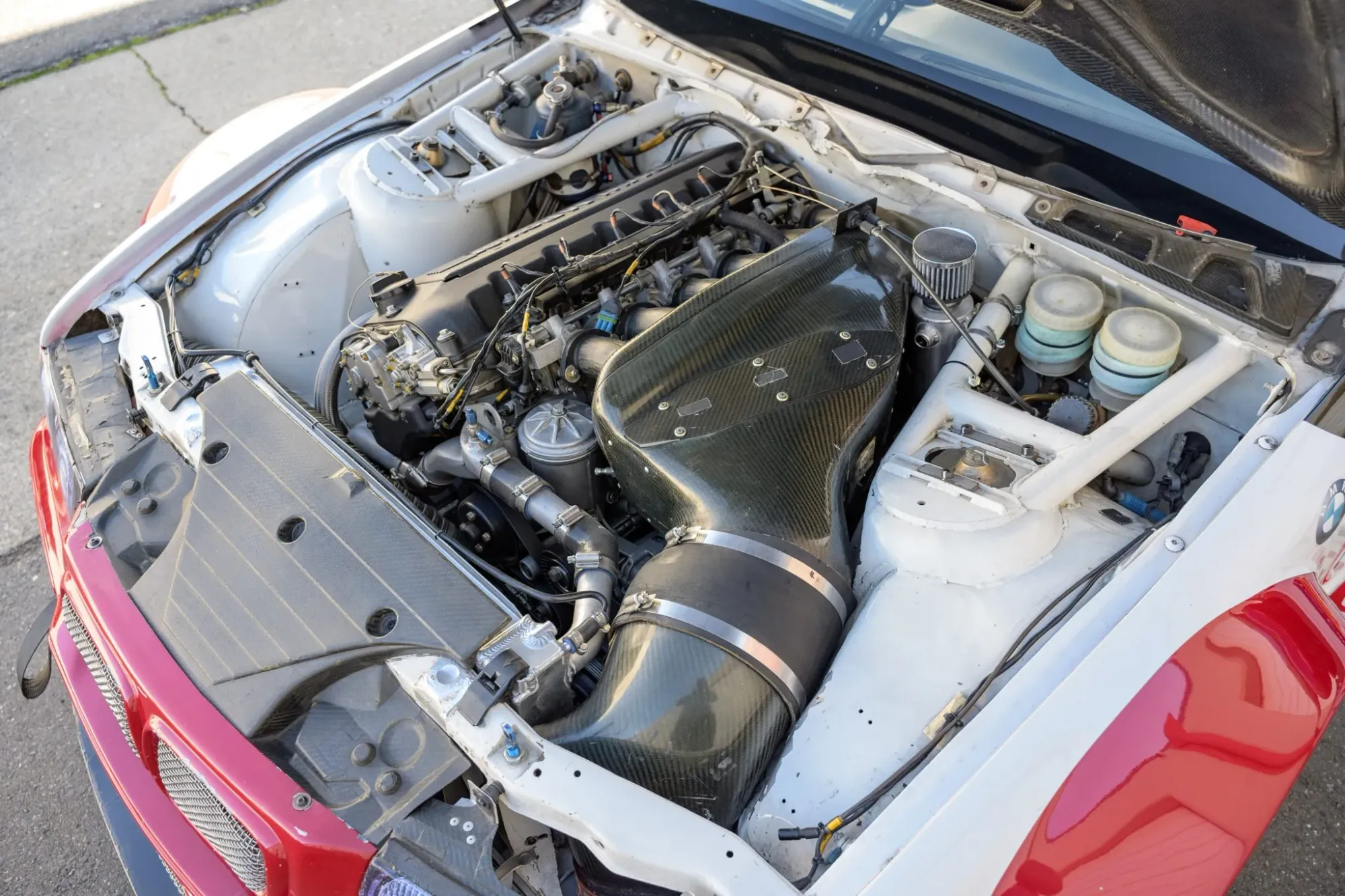
Engine Bay
Again, a lot of cool stuff going on in the engine bay. The engine is said to be an S50B32 (Euro), dual VANOS that has been stroked to 3.4L. It has a dry sump system as mentioned. The airbox is positively massive, and probably a custom PTG piece.
The engine loom is custom, with milspec bulkhead connectors.
While the pedal box in the interior looked original/factory, we see individual reservoirs for the master cylinder(s) on the driver's side firewall. There is a custom expansion tank for the cooling system on the passenger's side firewall.
One subtle thing that I noticed is that the inner fender wells have been "tubbed" to allow more tire clearance for the large 280/650-18 tires. The fender wells are much larger and taller than factory.
The tops of the shock towers are extensively reworked for strength and the use of a custom slotted camber plate setup.
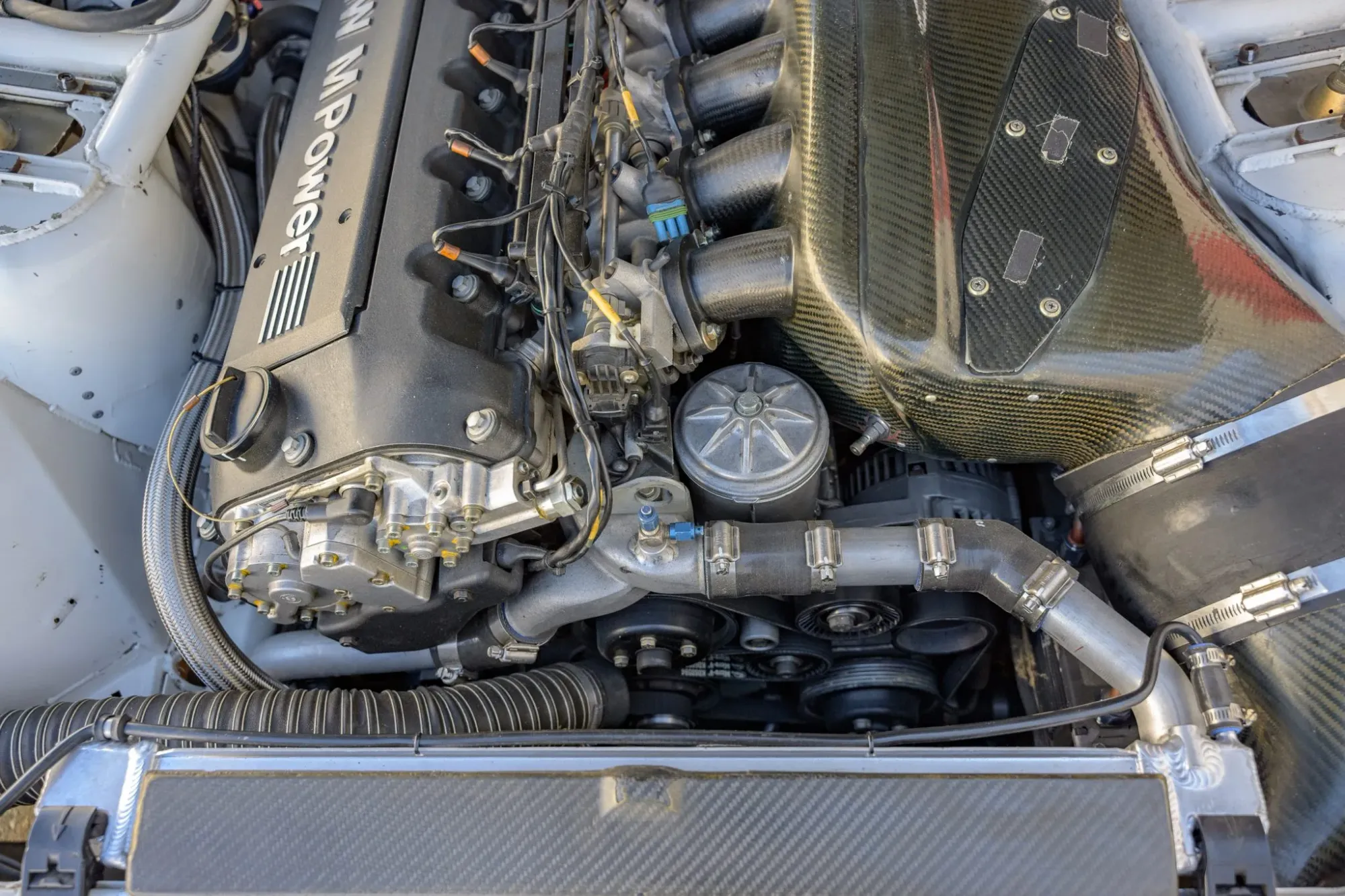
Front Engine Bay
Here we can see the use of one of the ducts from the front bumper (coming from the left of the photo). This cooling duct seems to be aimed at the crank damper. Maybe the damper was overheating from high revs?
The tee on the thermostat housing could be for bleeding, or maybe for sensors that are not in use.
There looks to be some sort of Schrader valve on the airbox. Not sure what that would be used for.
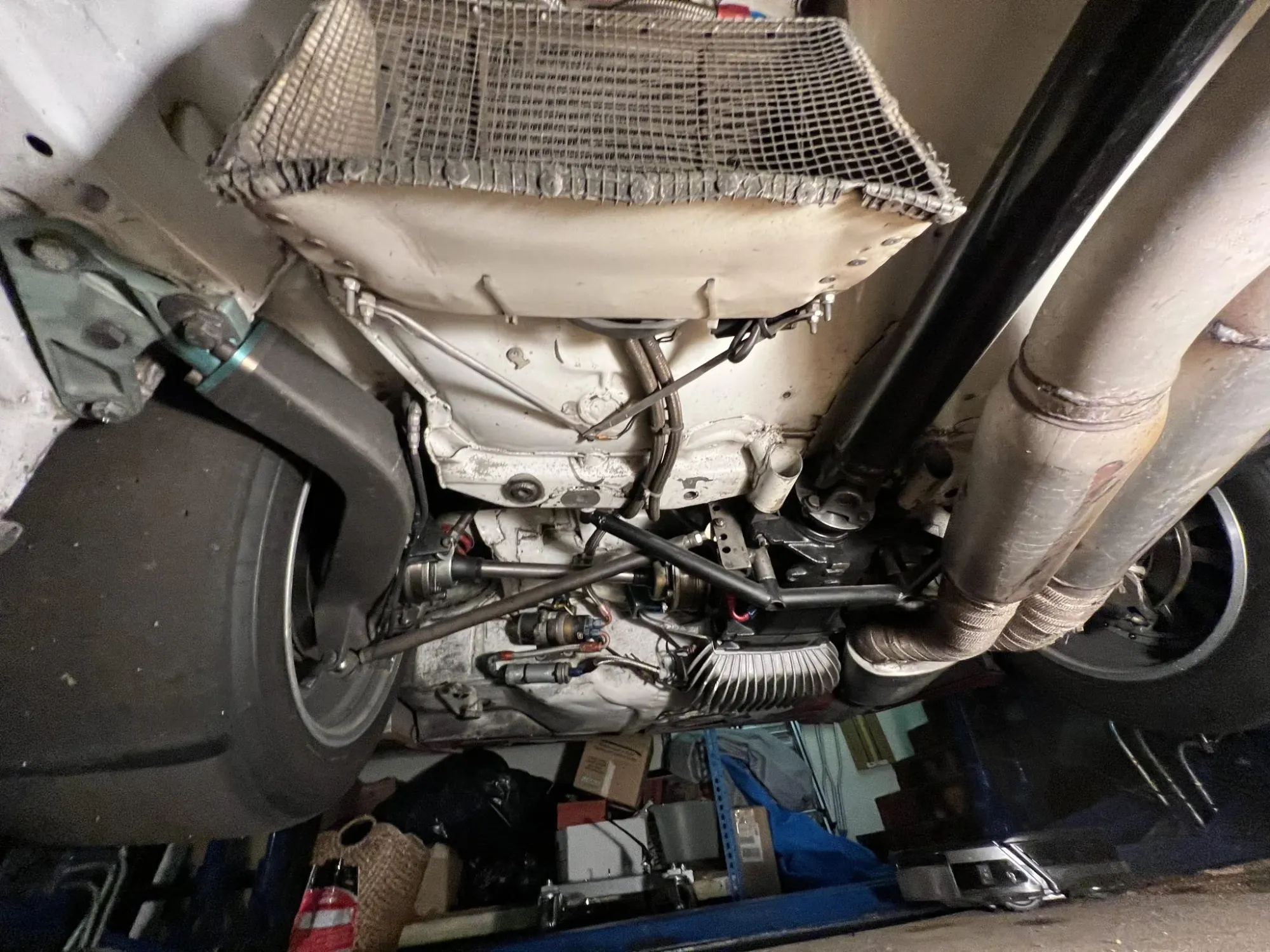
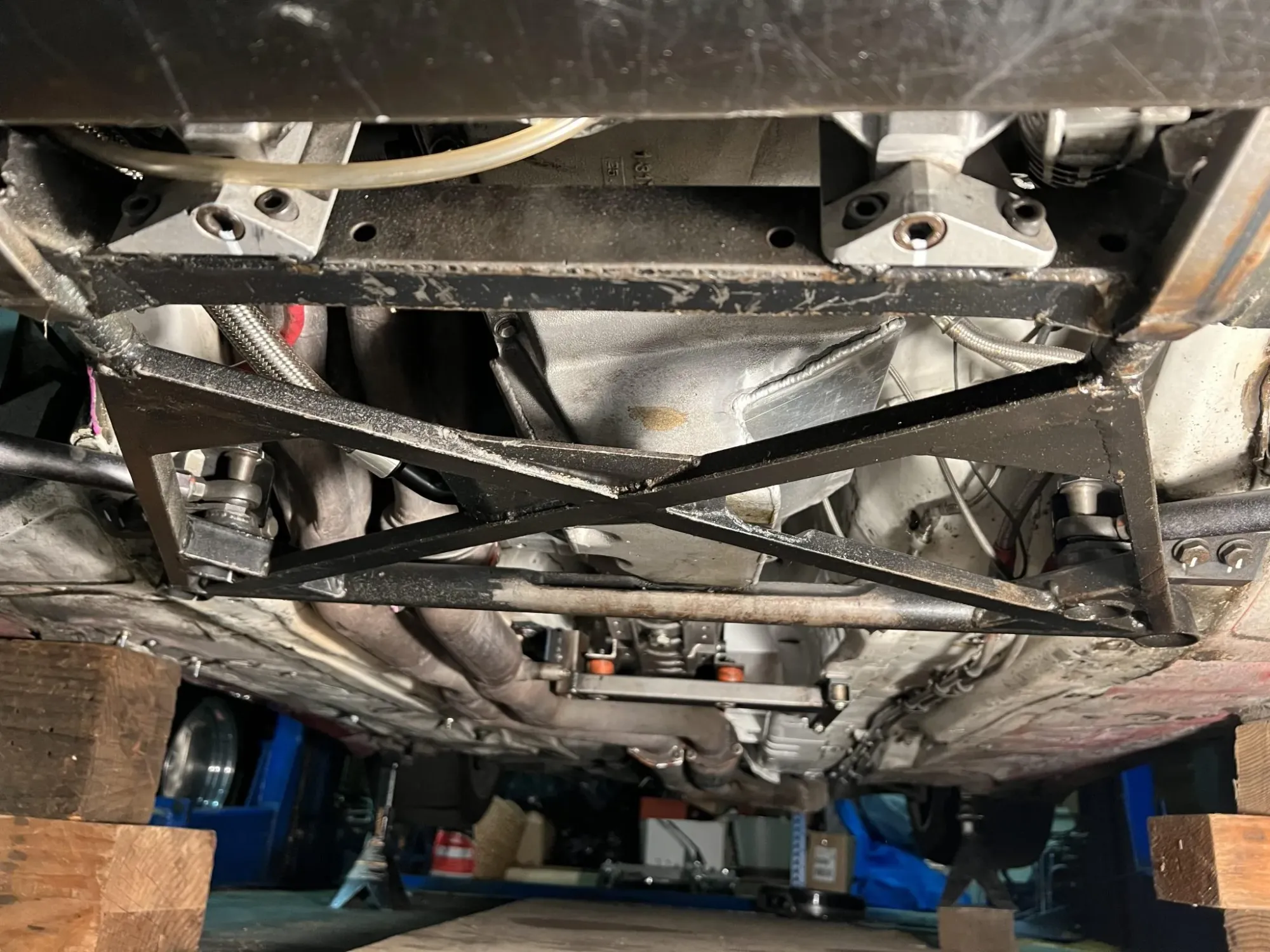
Underside
In the front we can see custom control arms that allow for roll center adjustments.
Custom cross members are in place for both the engine and the sequential transmission.
In the rear we can see another custom subframe housing what is potentially an E30 differential (it appears to be mounted with vertical bolts like an E30). The rear arms are also custom, and the trailing arm seems to have adjustments integrated into the body-side mount.
The differential cooler is mounted where the factory gas tank used to be.
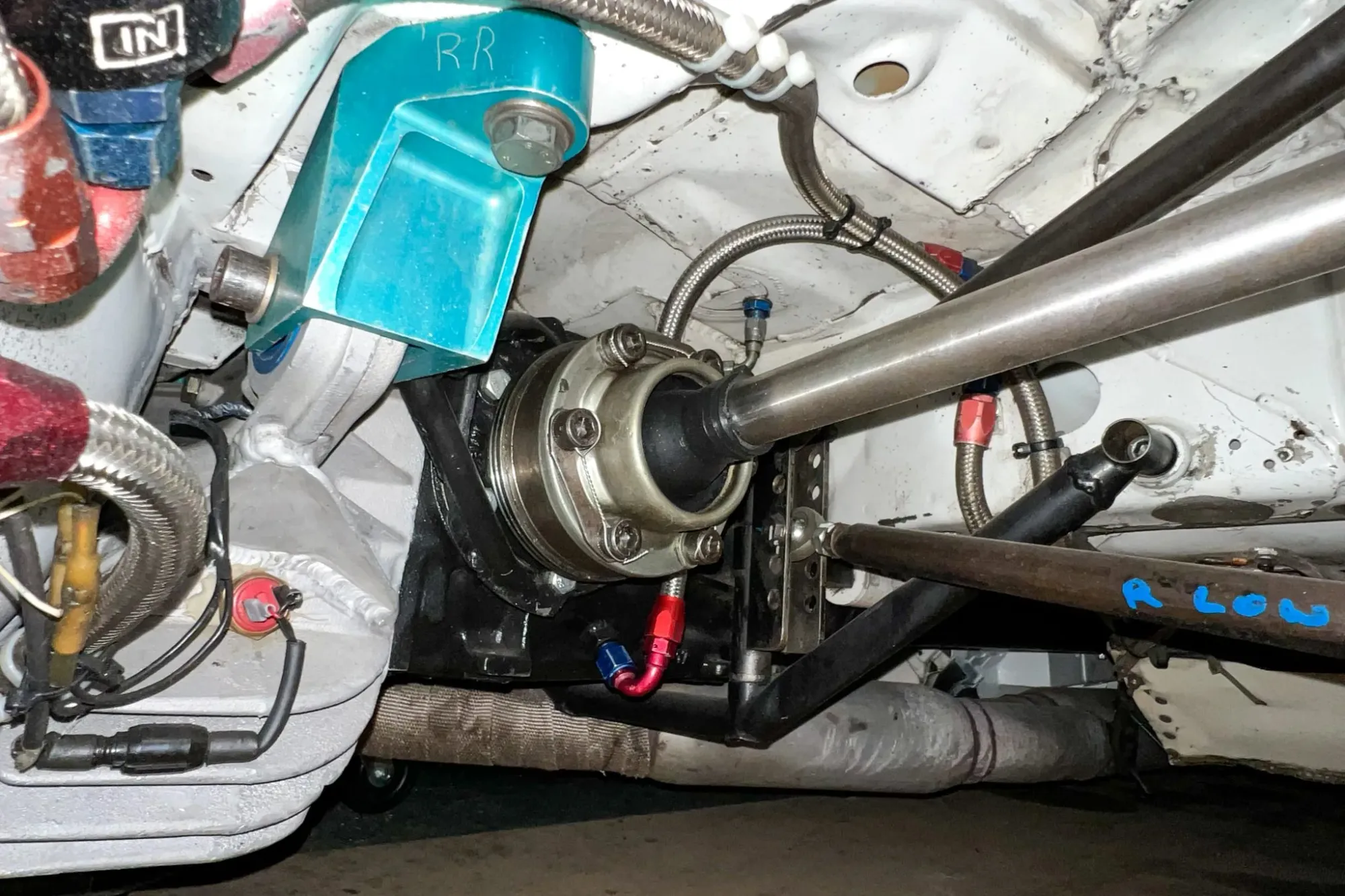
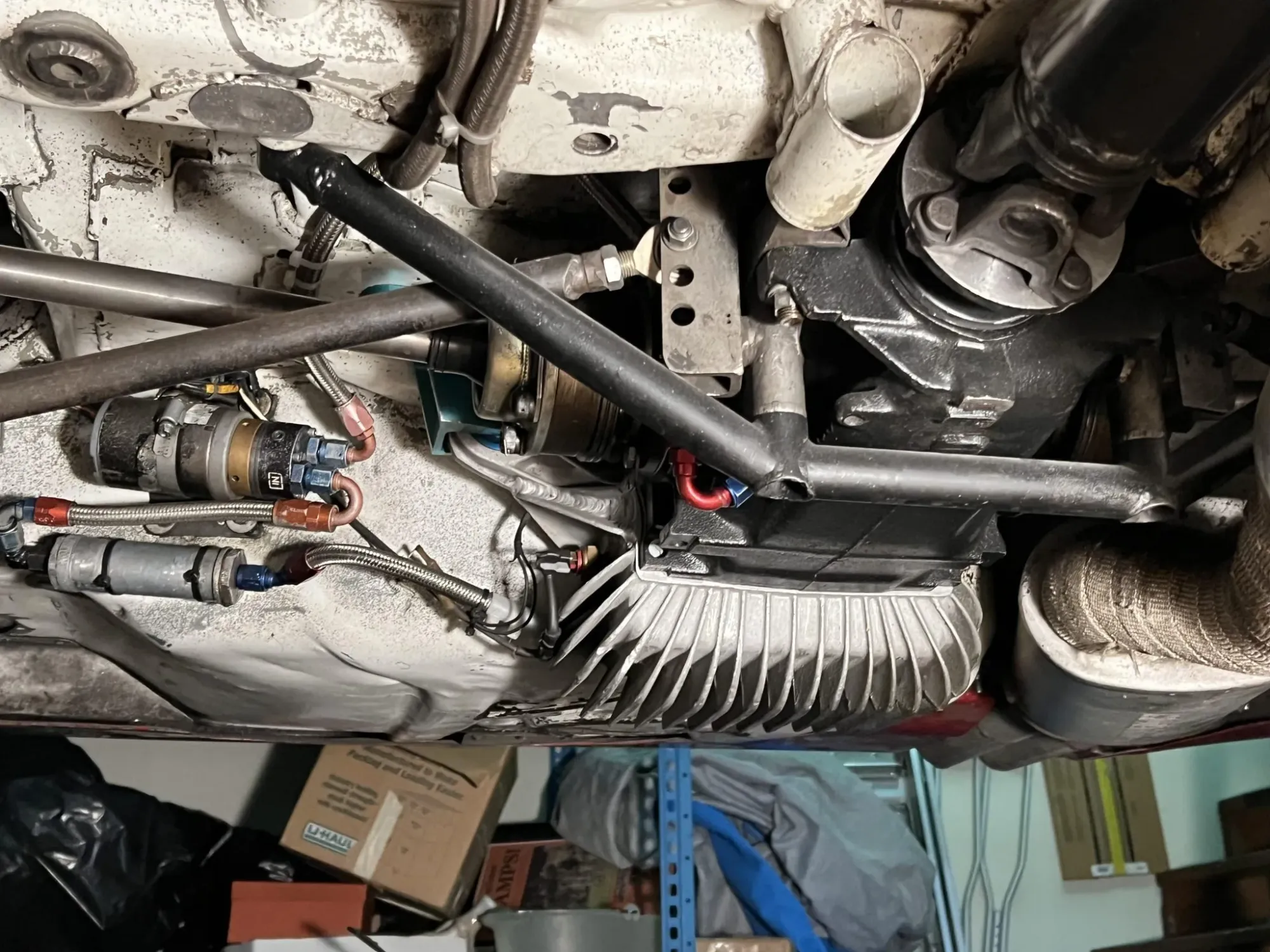
Rear Subframe Detail
The half-shafts appear to be custom. The mounting ears were welded to the differential cover. Not sure if that was custom, or a repair job.
You can see the mounting holes for the factory subframe have been reinforced, so they might have been running a factory subframe at some point in time. The rear differential mounting tabs are aftermarket anodized aluminum.
Overall the rear suspension design is similar to factory, but much more adjustable.
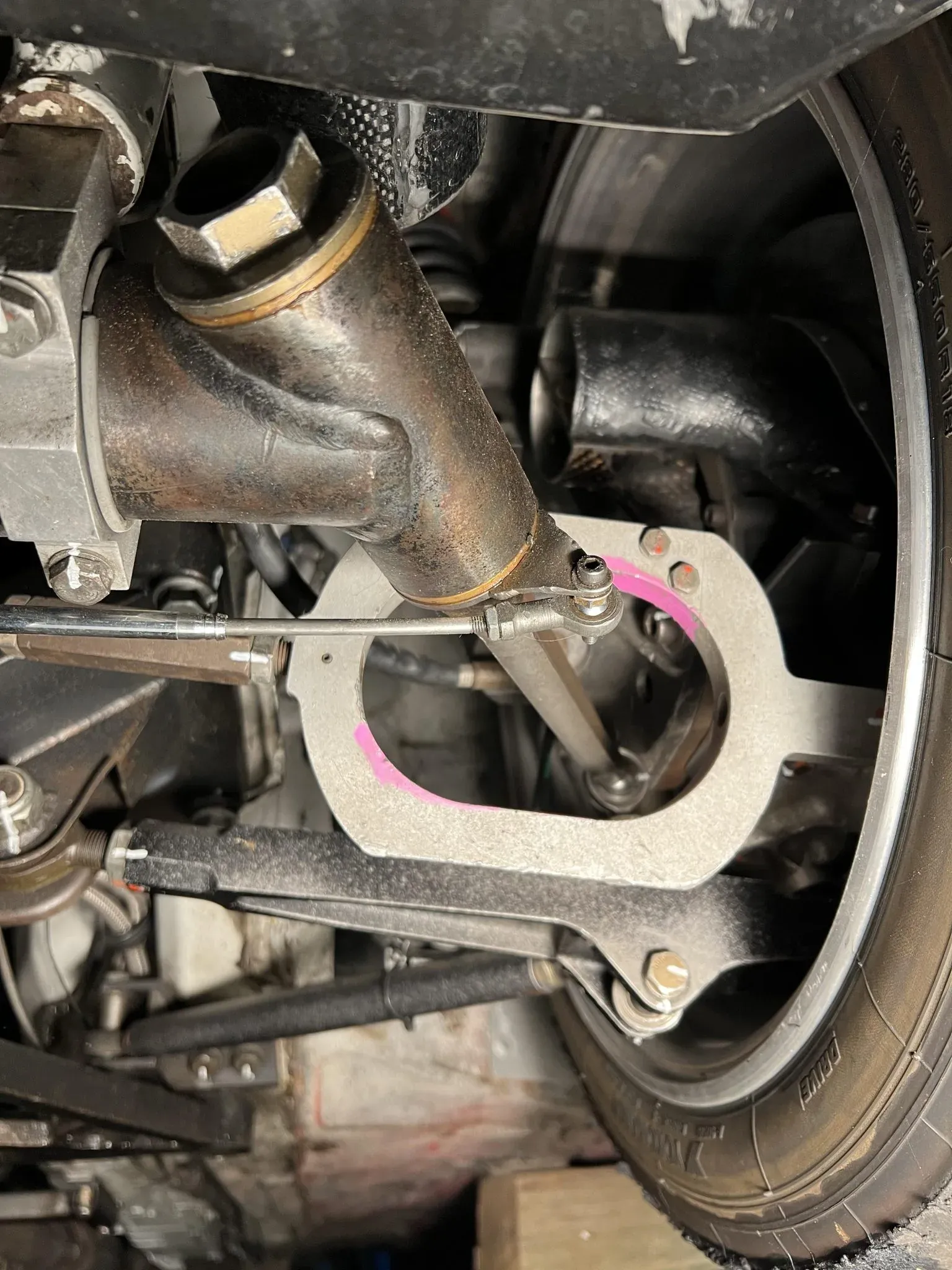
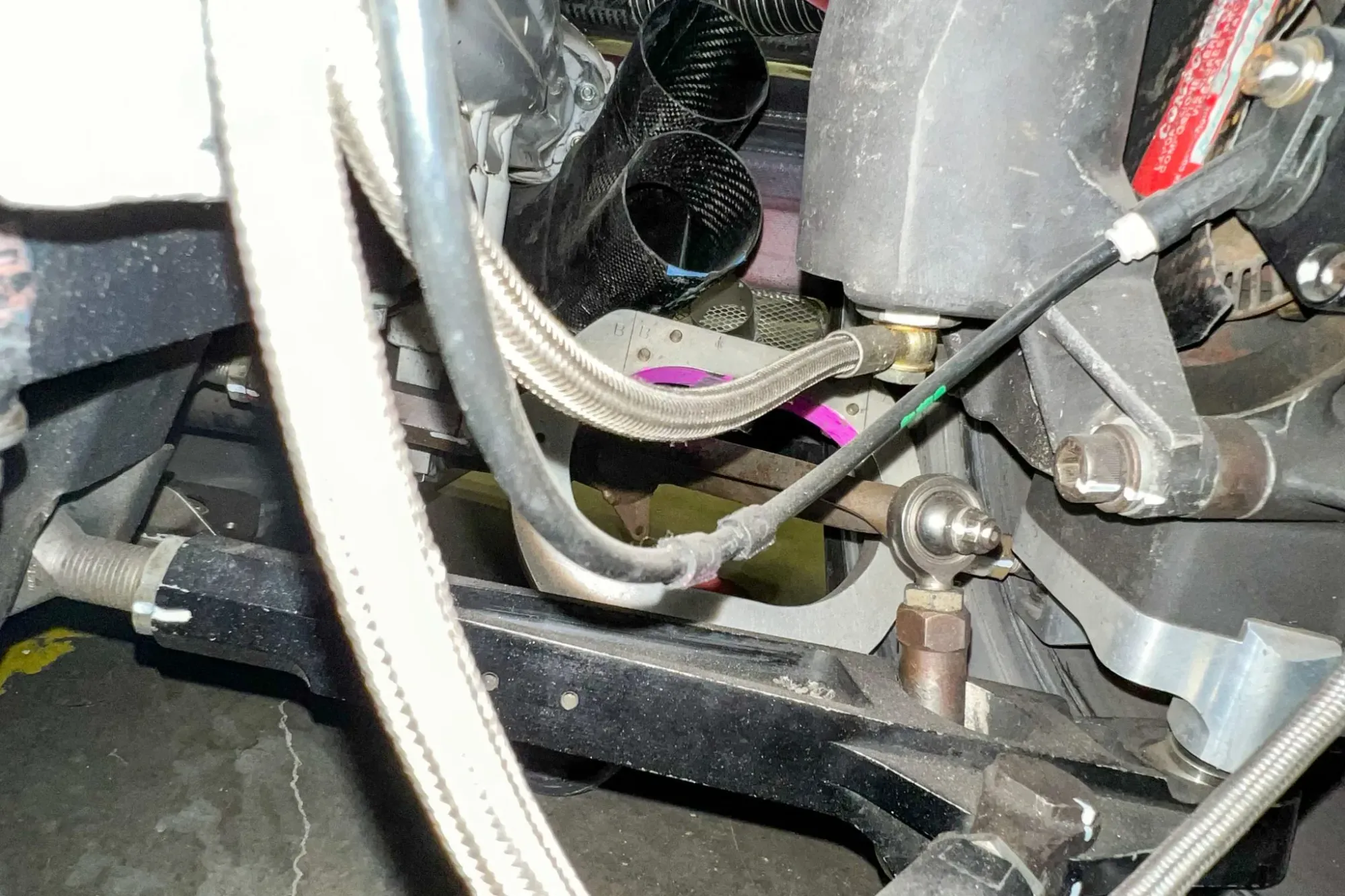
Front Suspension Details
Unfortunately not much can be seen of the front upright, but it definitely appears to be custom. The front control arms and custom inboard pickup points can be seen. Assume that the pickup points are raised to correct the front roll center. Front track width and arm sweep can be adjusted with the heim joints.
There is a thick roll center spacer underneath the outboard upright.
The mechanism for the adjustable sway bar can be seen. I believe that this works by turning the "blade," which adjusts how much tension the bar creates. I could very well be wrong on this.
A large oval shaped opening is used as part of the steering tie rod, to ensure the sway bar and tie rods don't interfere.
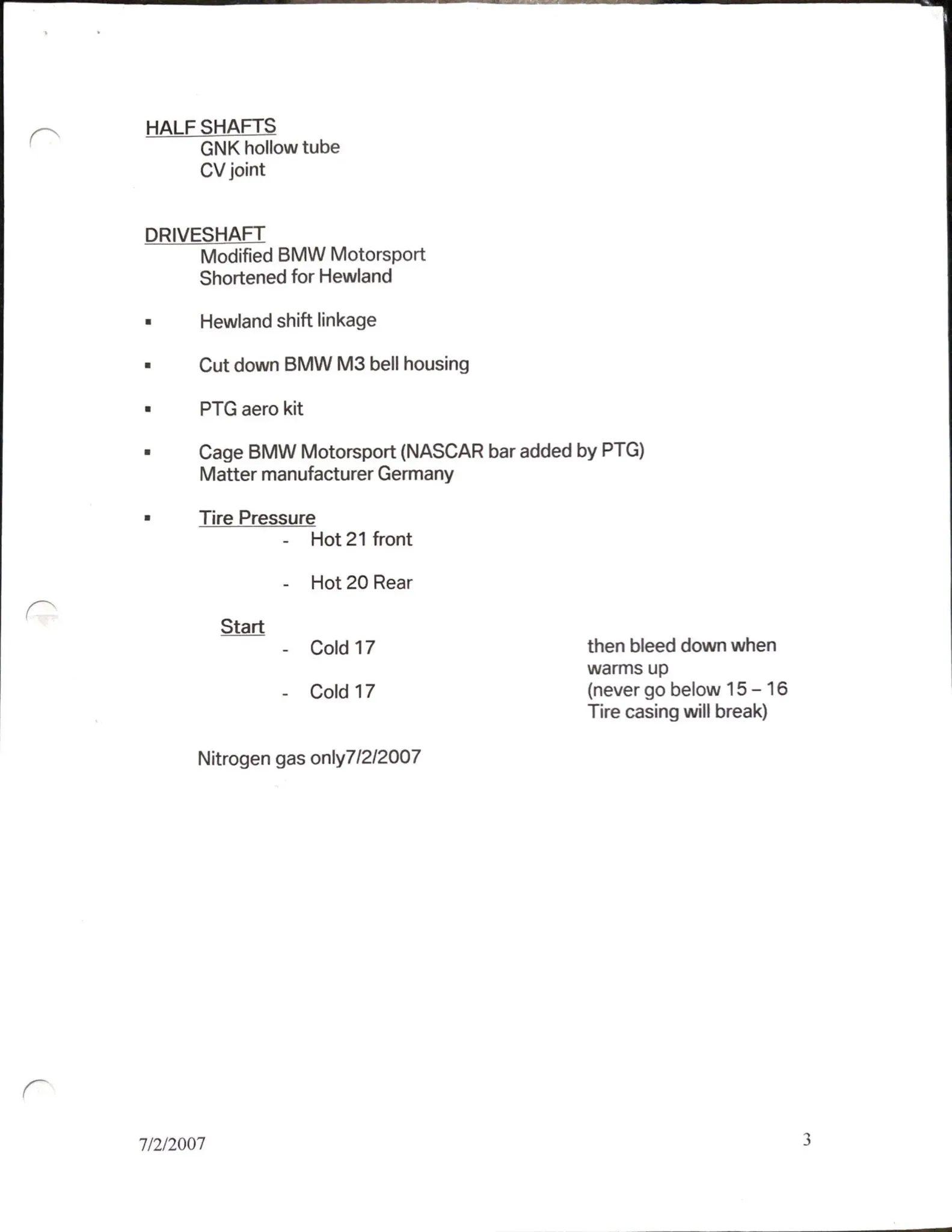
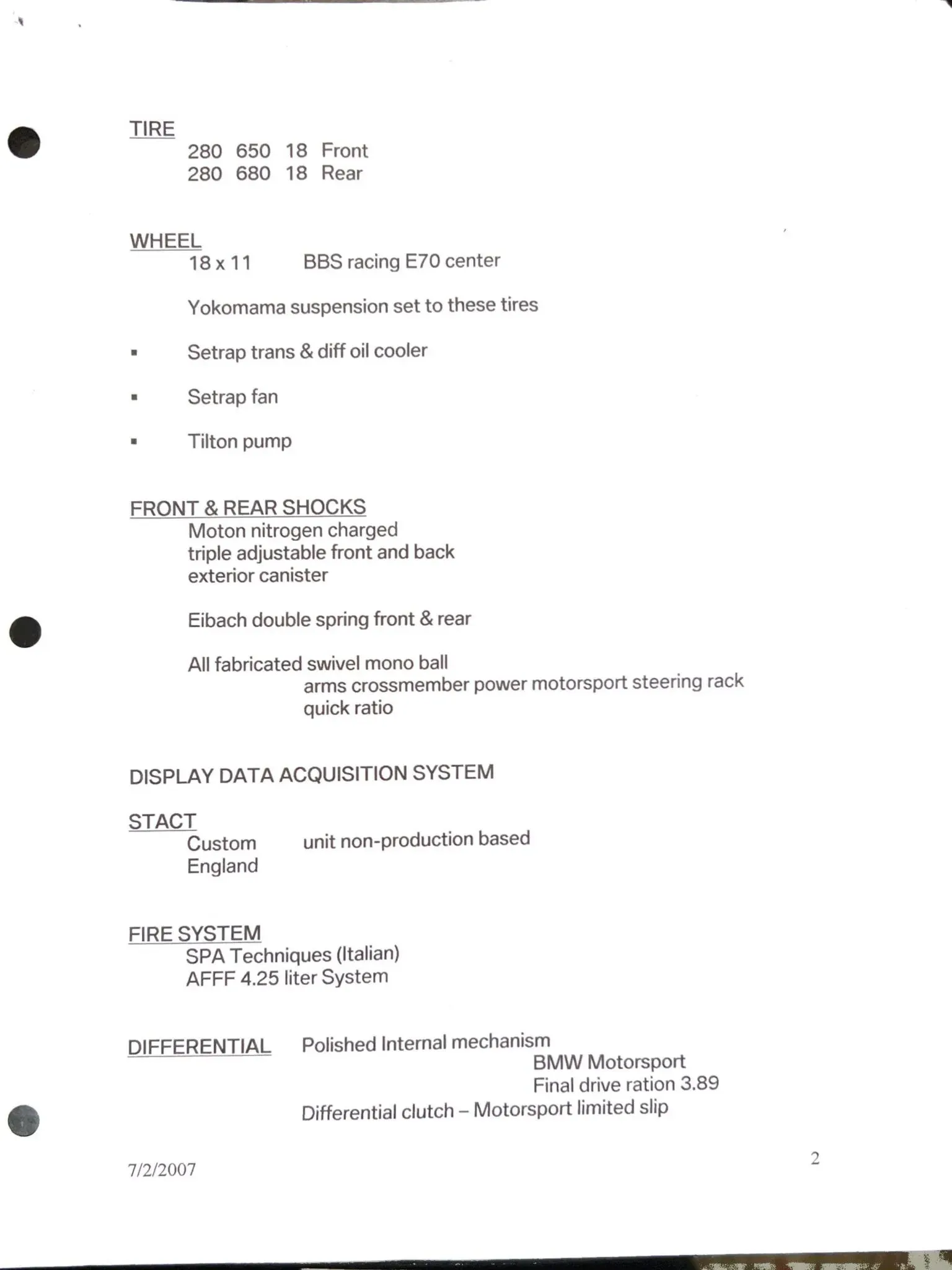
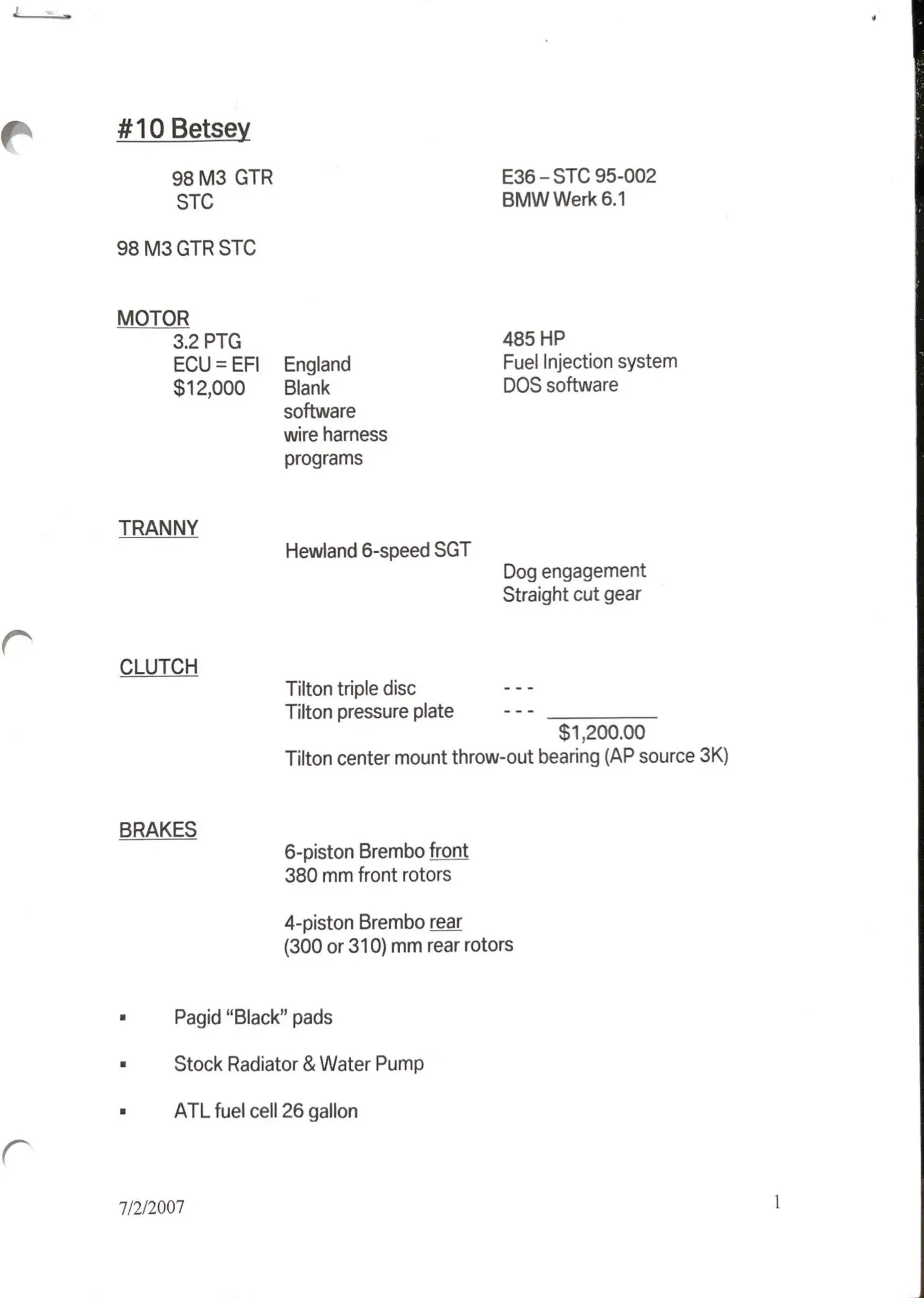
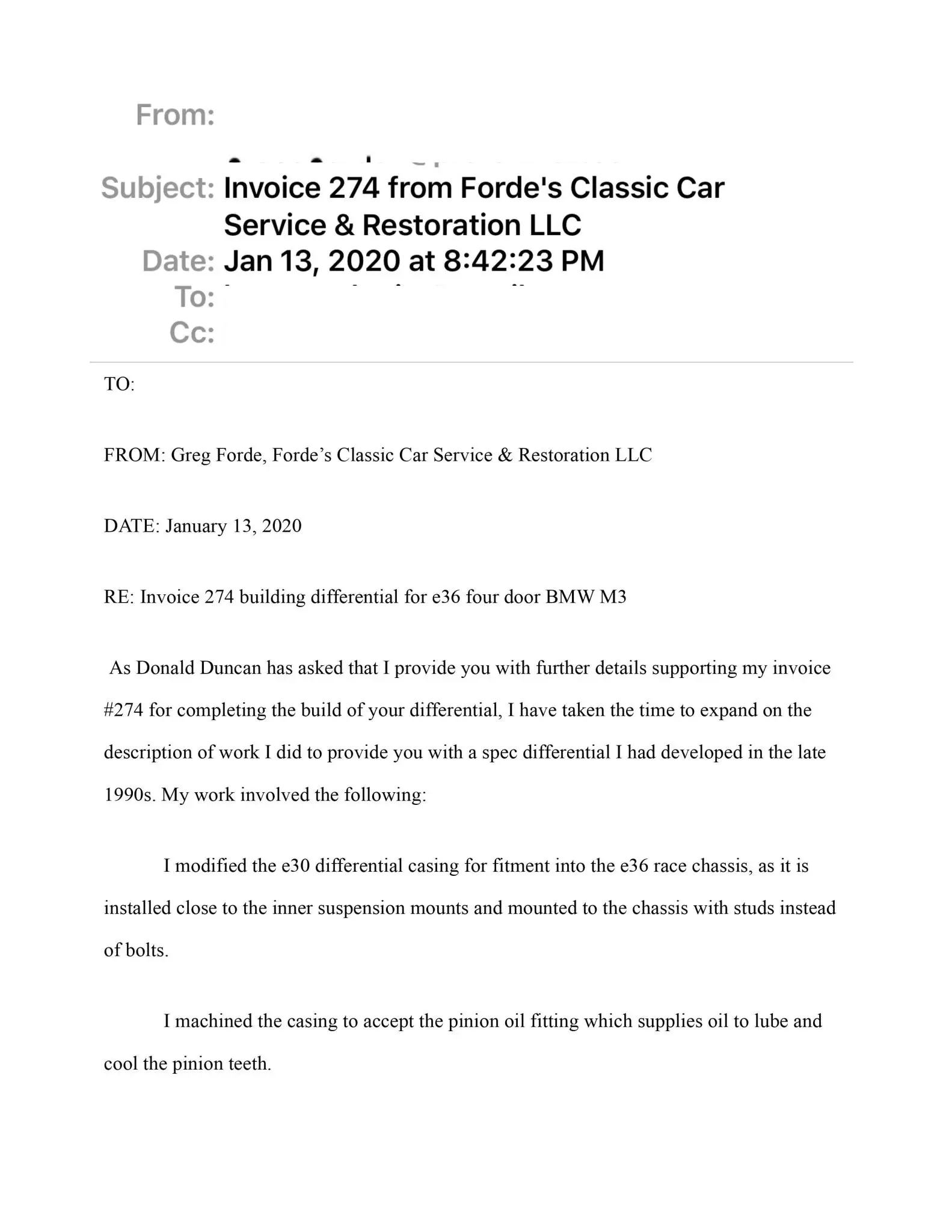
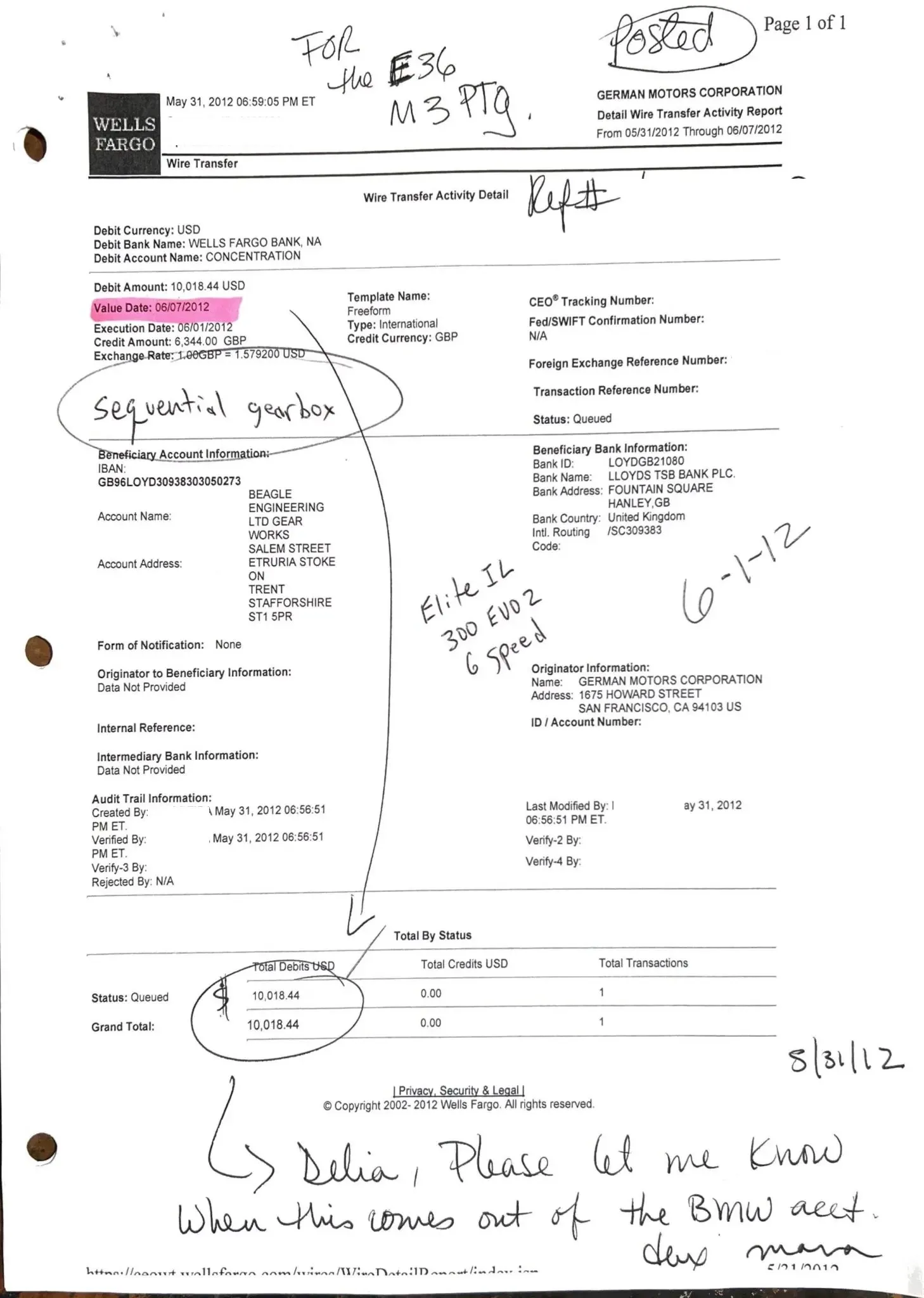
Paperwork
Some receipts and paperwork are provided with the car, including press coverage and some historical documents surrounding the car's success. After it's professional life, the car has been club raced with various organizations like BMWCCA and NASA.
Some of the receipts are interesting. The Elite sequential that is in the car now was $10,018.44 in 2012. Relatively inexpensive, actually. A set of tires in 2012 cost $2,154.64.
There is documentation from the differential builder. It seems the diff was rebuilt or entirely recreated, and it does confirm that an E30 diff was used (along with a ton of customization).
There is a spec sheet dated 2007 that says the engine is "3.2L PTG" and 485hp. "ECU = EFI" with DOS software. It does note that at the time it had a Hewland dog box and Tilton triple disc clutch.
It had a stock radiator and water pump at the time (!). The radiator in there now is a thick (S54?) aluminum radiator. I would have guess there would be a Stewart water pump in there.
It notates that the wheels are 18x11" BBS E70.
It describes the suspension as Moton triple-adjustable with dual rate Eibach springs (stacked tenders). That is a trick setup that is hard to setup properly. It mentions that the steering rack is a custom motorsport quick ratio.
I spotted various typos in the spec sheet:
- Yokomama (Yokohama)
- Setrap (Setrab)
- Stact (Stack)
- GNK (GKN)
Another interesting insight is that the chassis was supplied by BMW Motorsport with the cage, which was done by Matter. Most of the E30 M3 DTM cars had Matter cages, too. I don't know if that relationship continued on after the E36. It is noted that PTG added the NASCAR door bars to the driver's side.
The tire pressures seem low (17 cold, 20 hot, using nitrogen), but I have no experience whatsoever with real racing slicks.
In Summary
All in all, a truly incredible and historic race car. It was a pleasure to be able to see it in such great detail via the 255 photos included with the auction. I hope the car continues to be raced by the winner of the auction.
